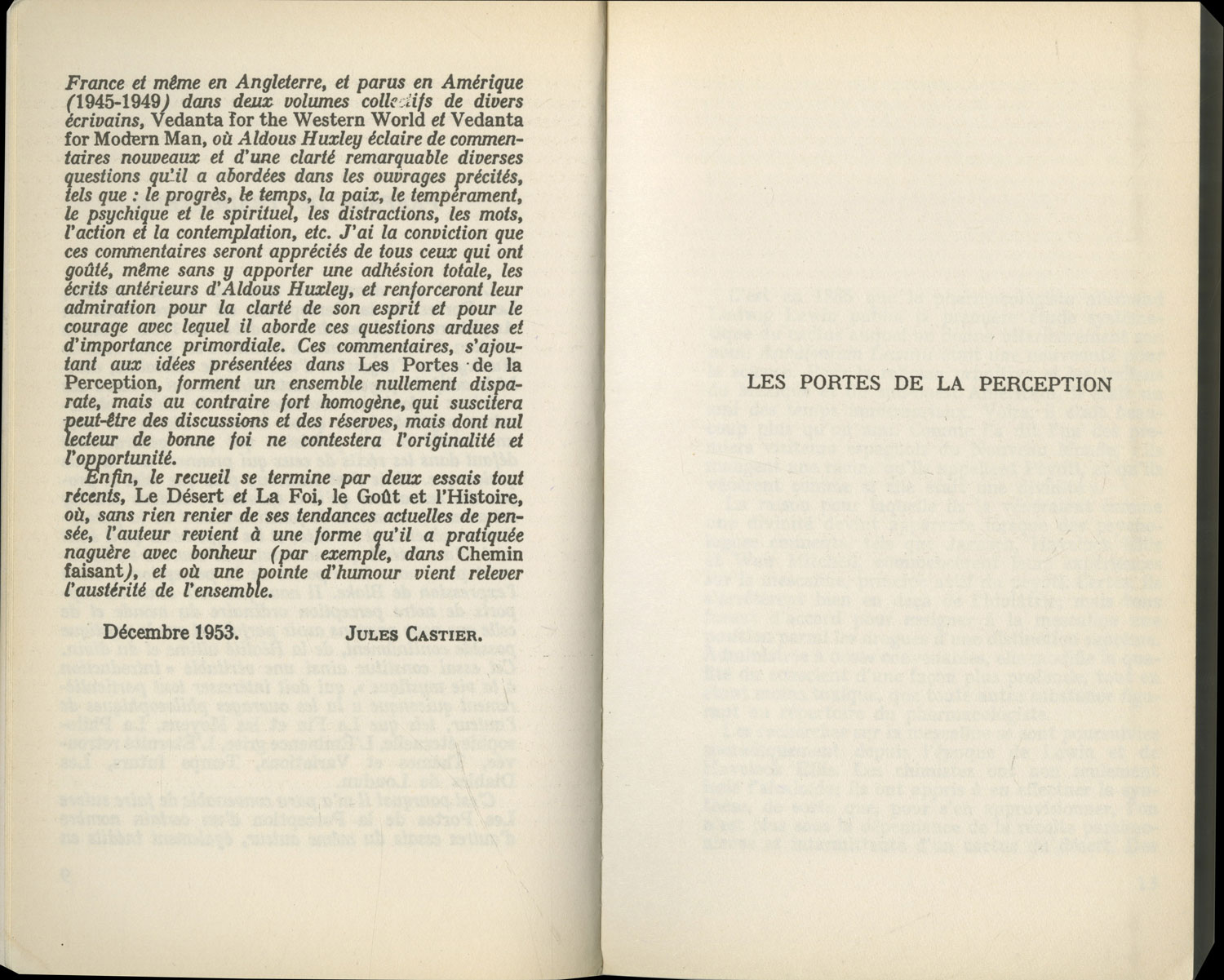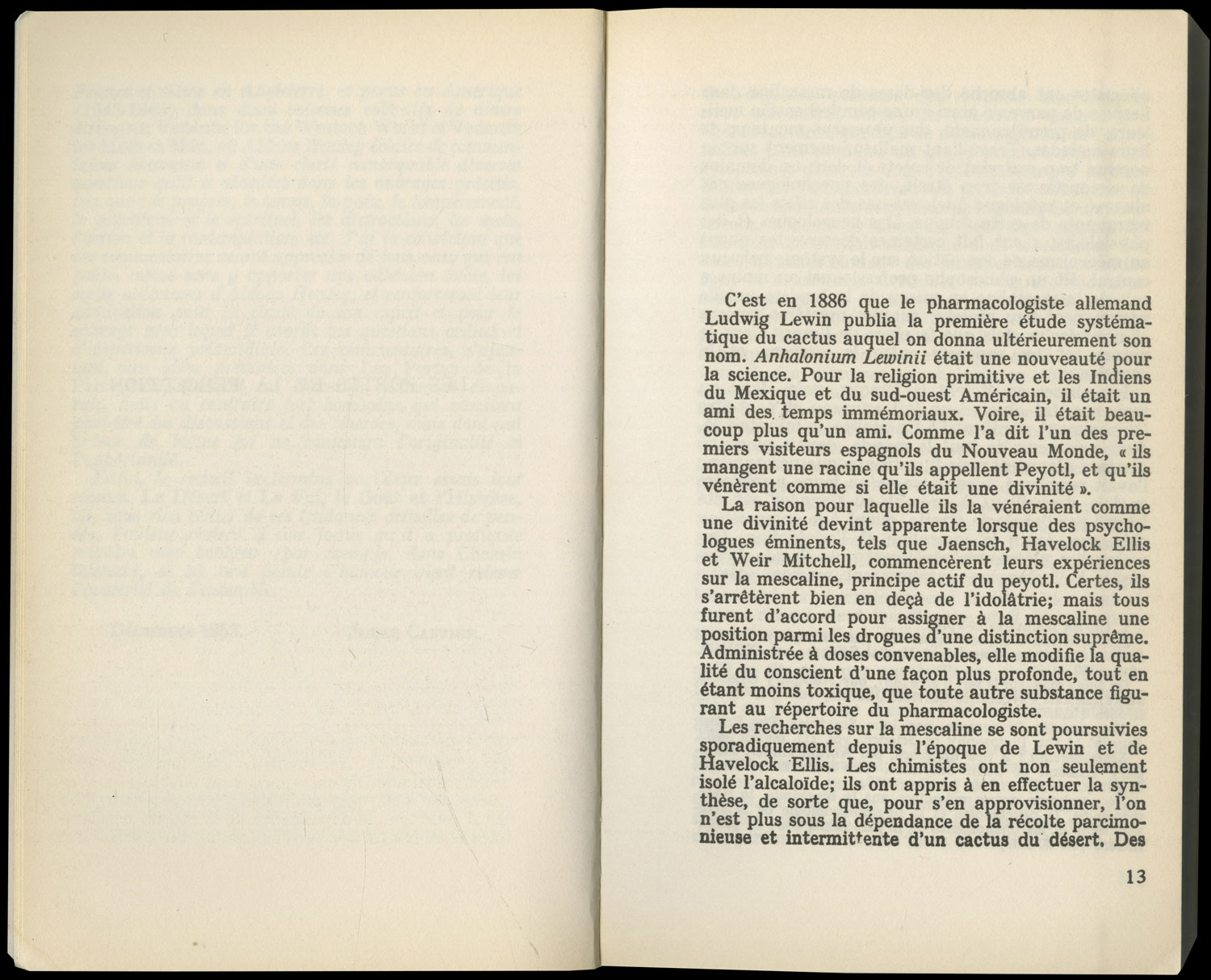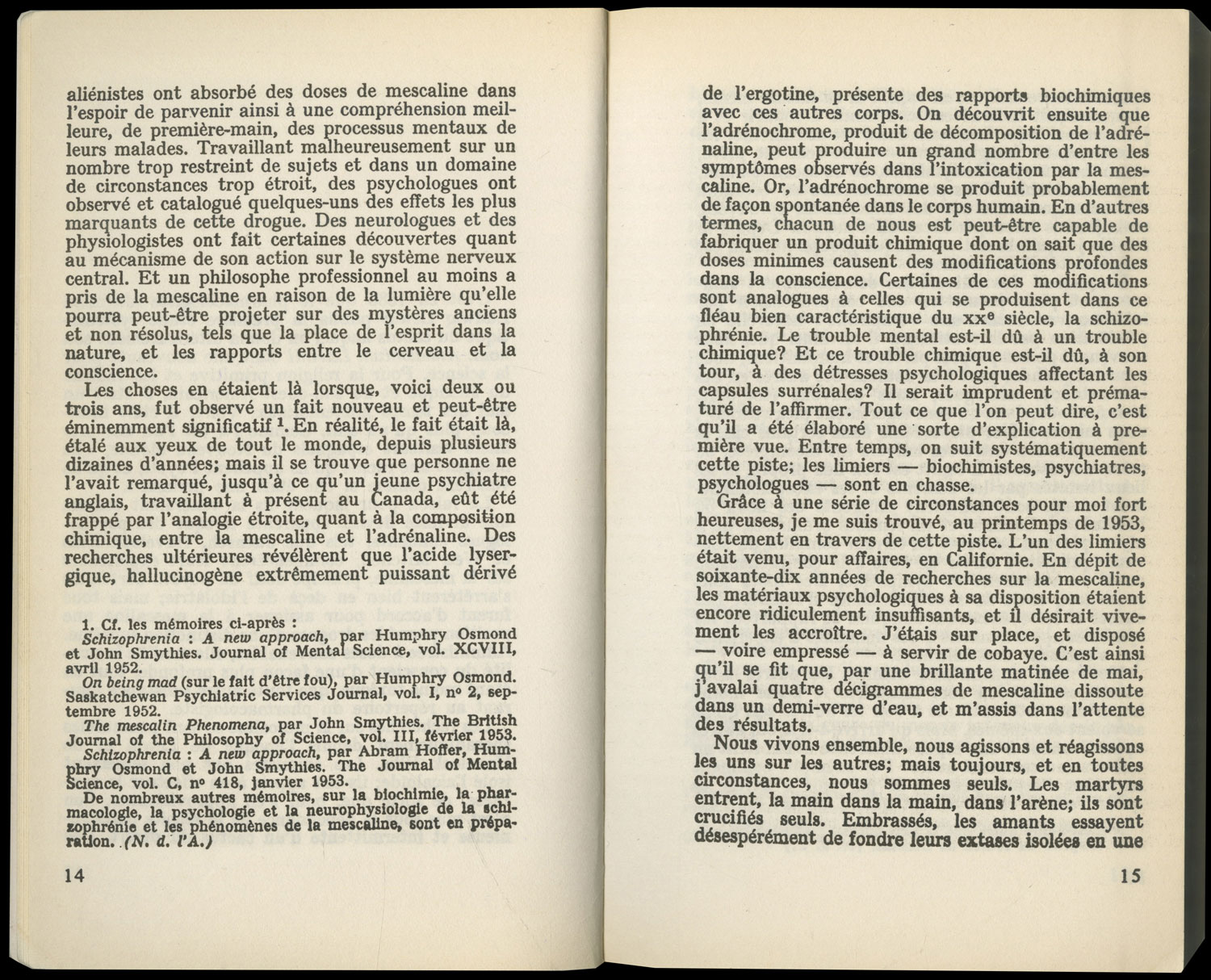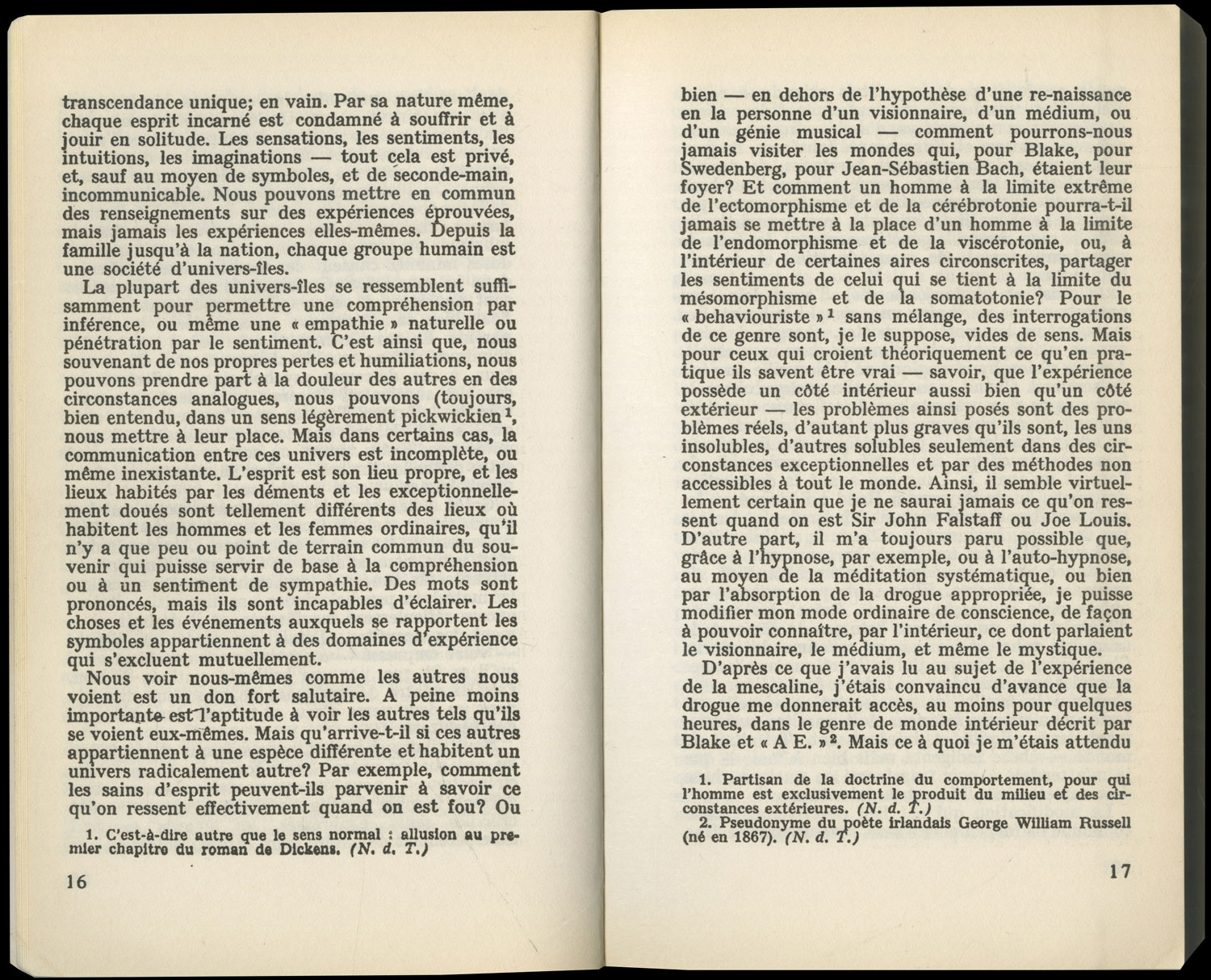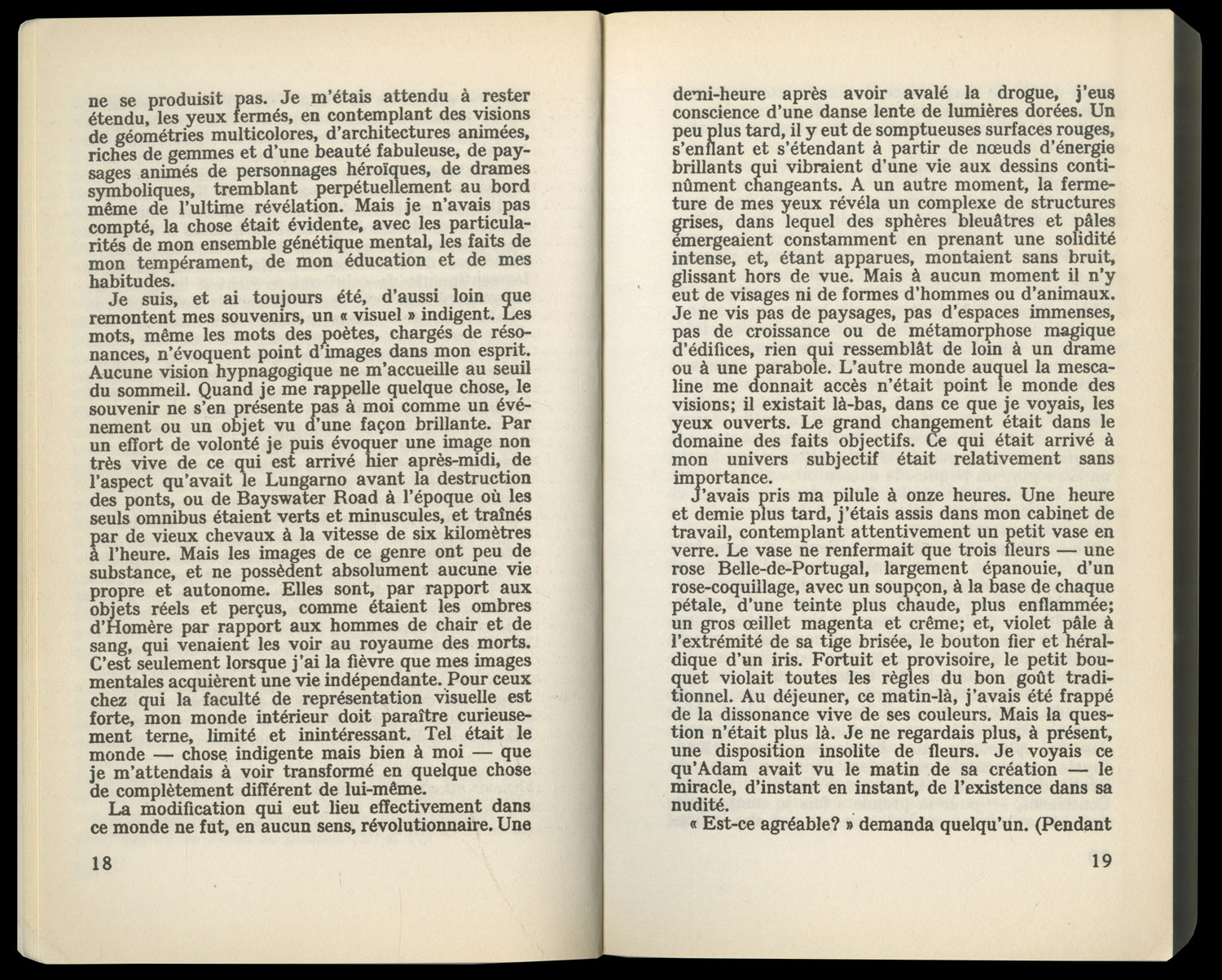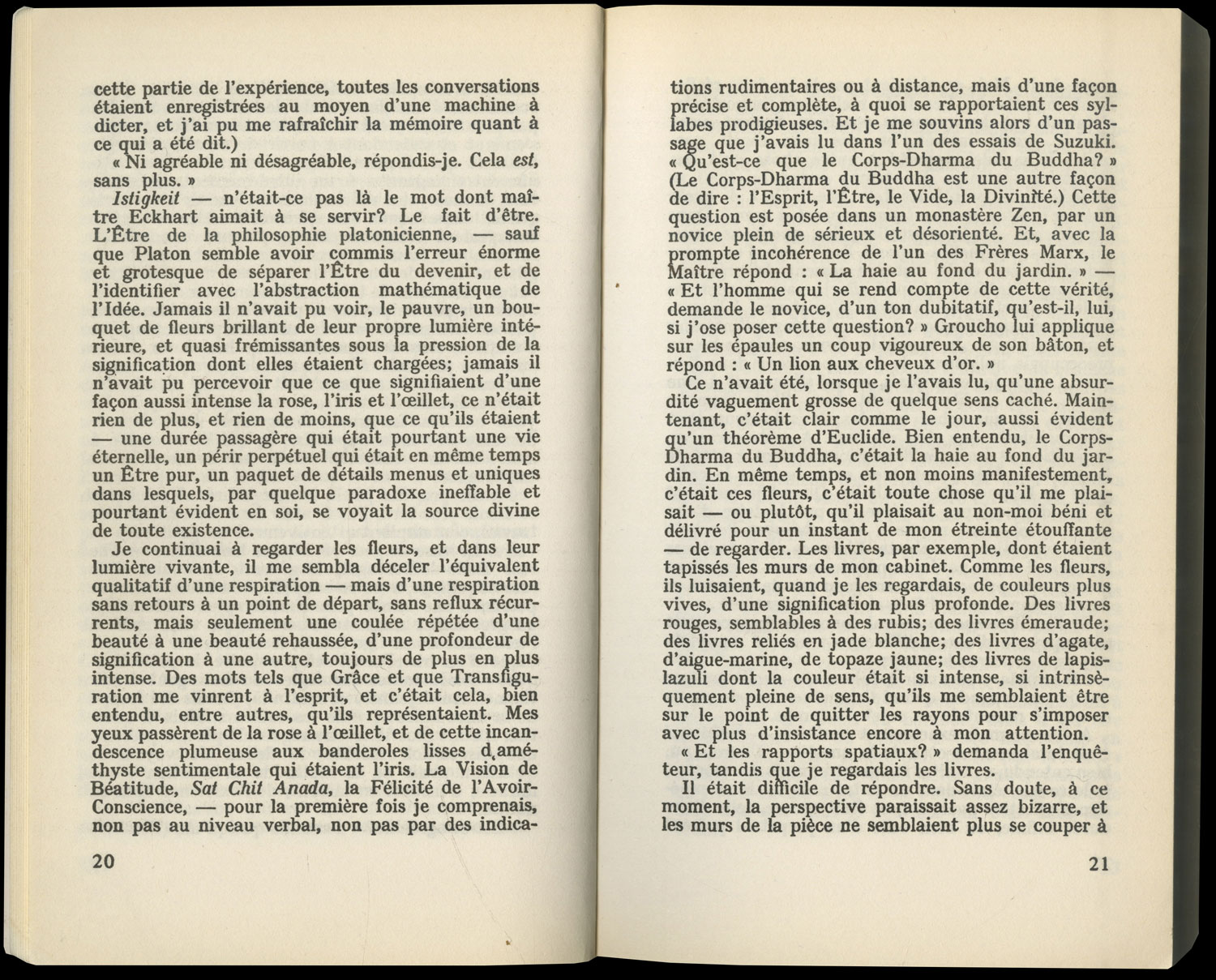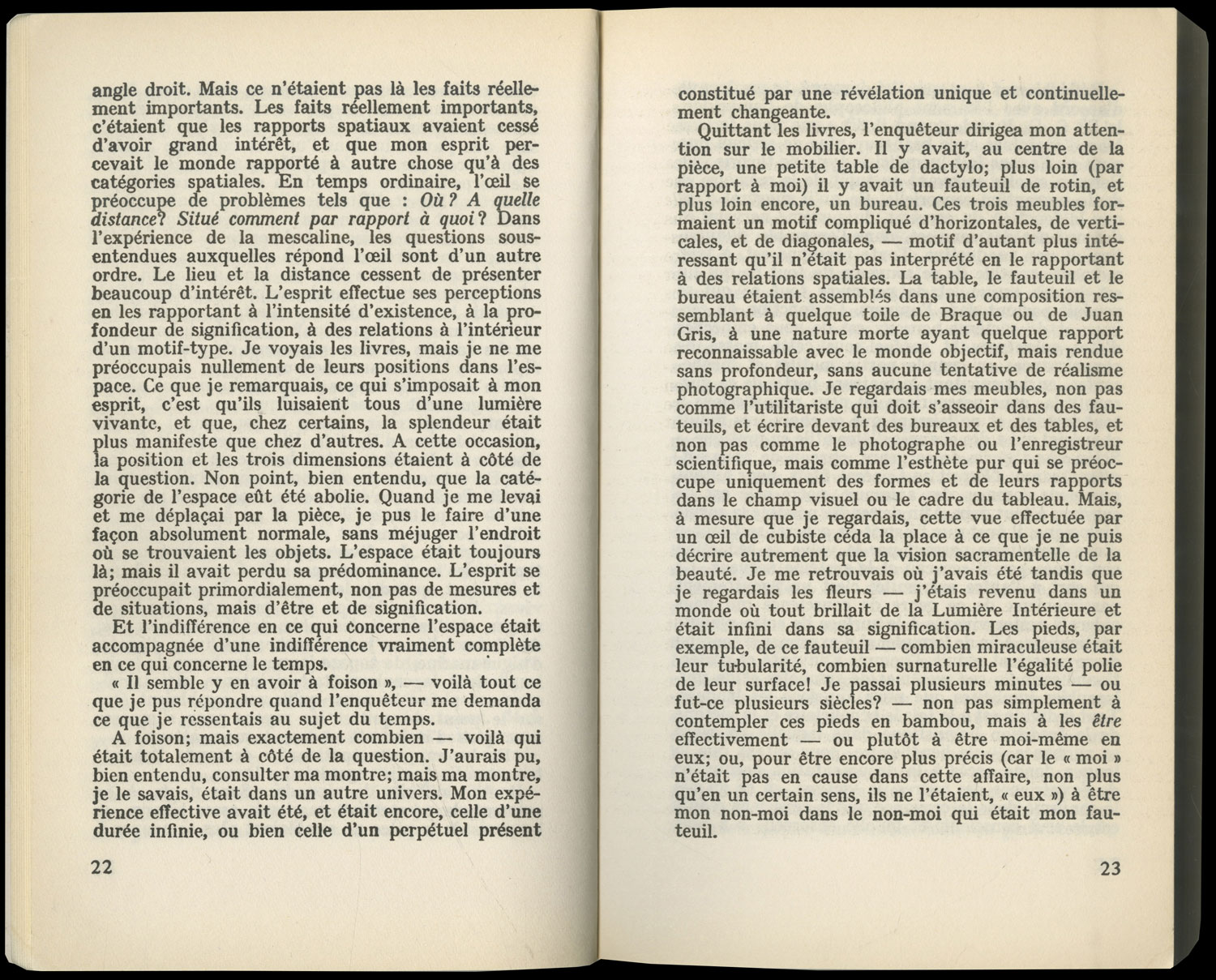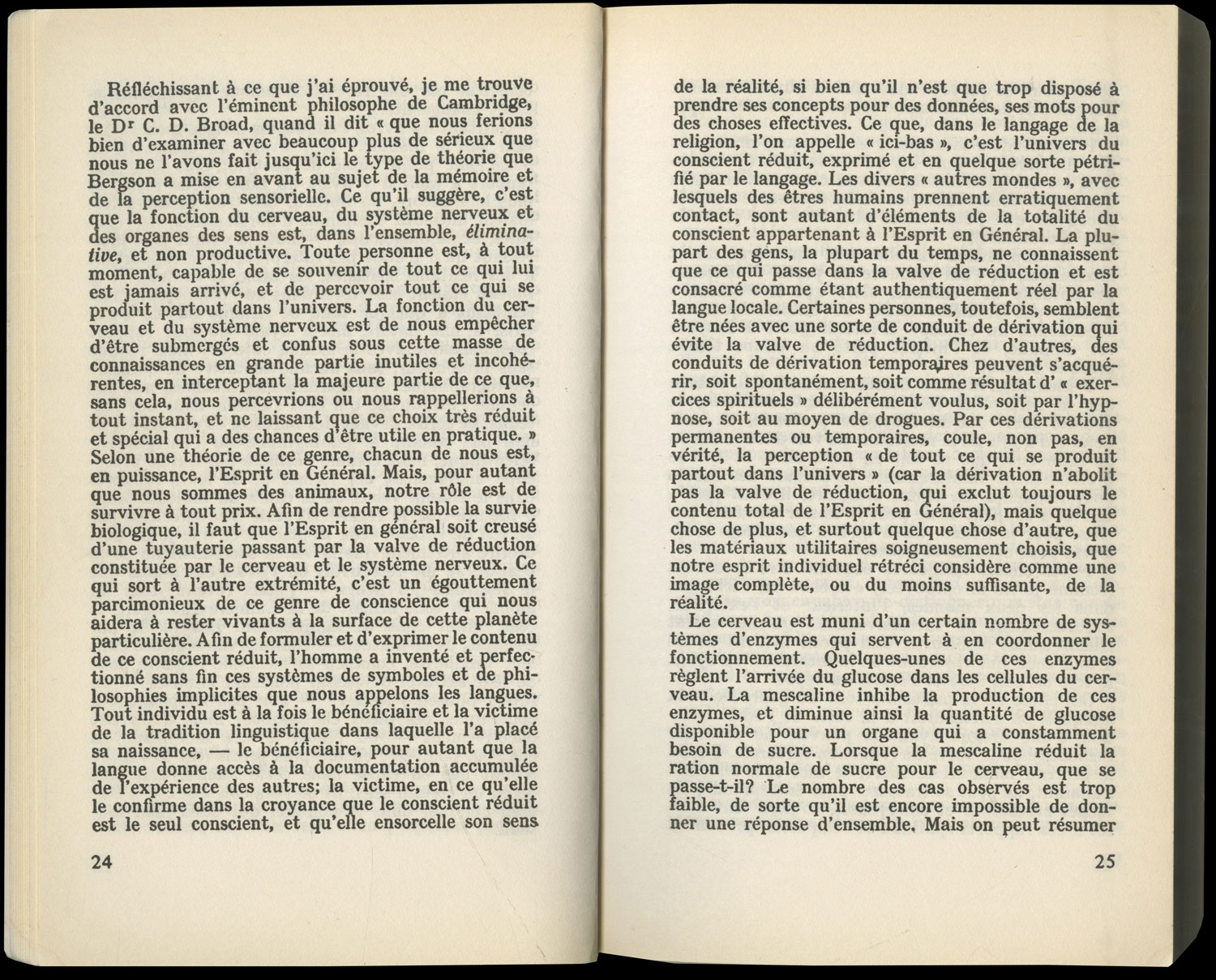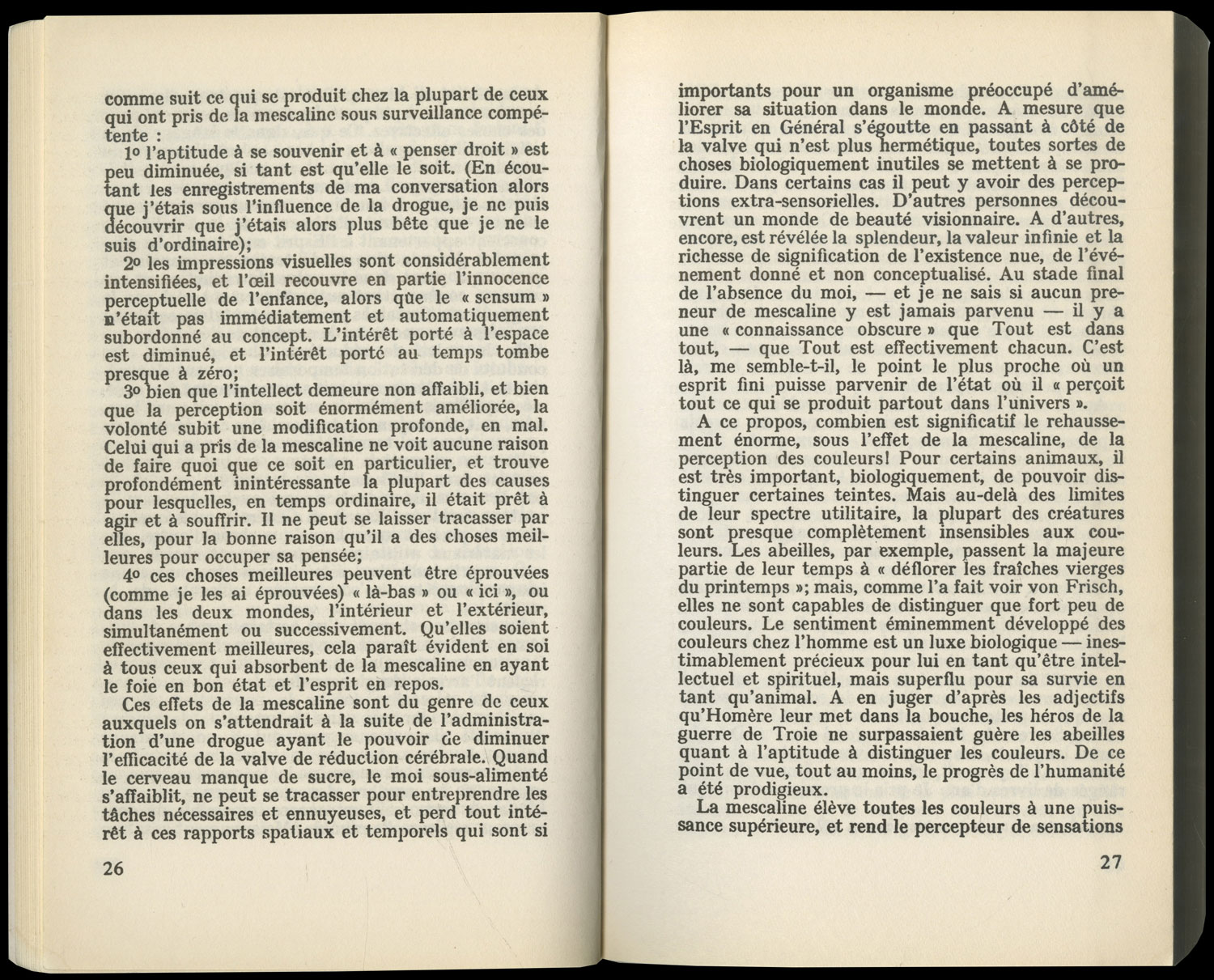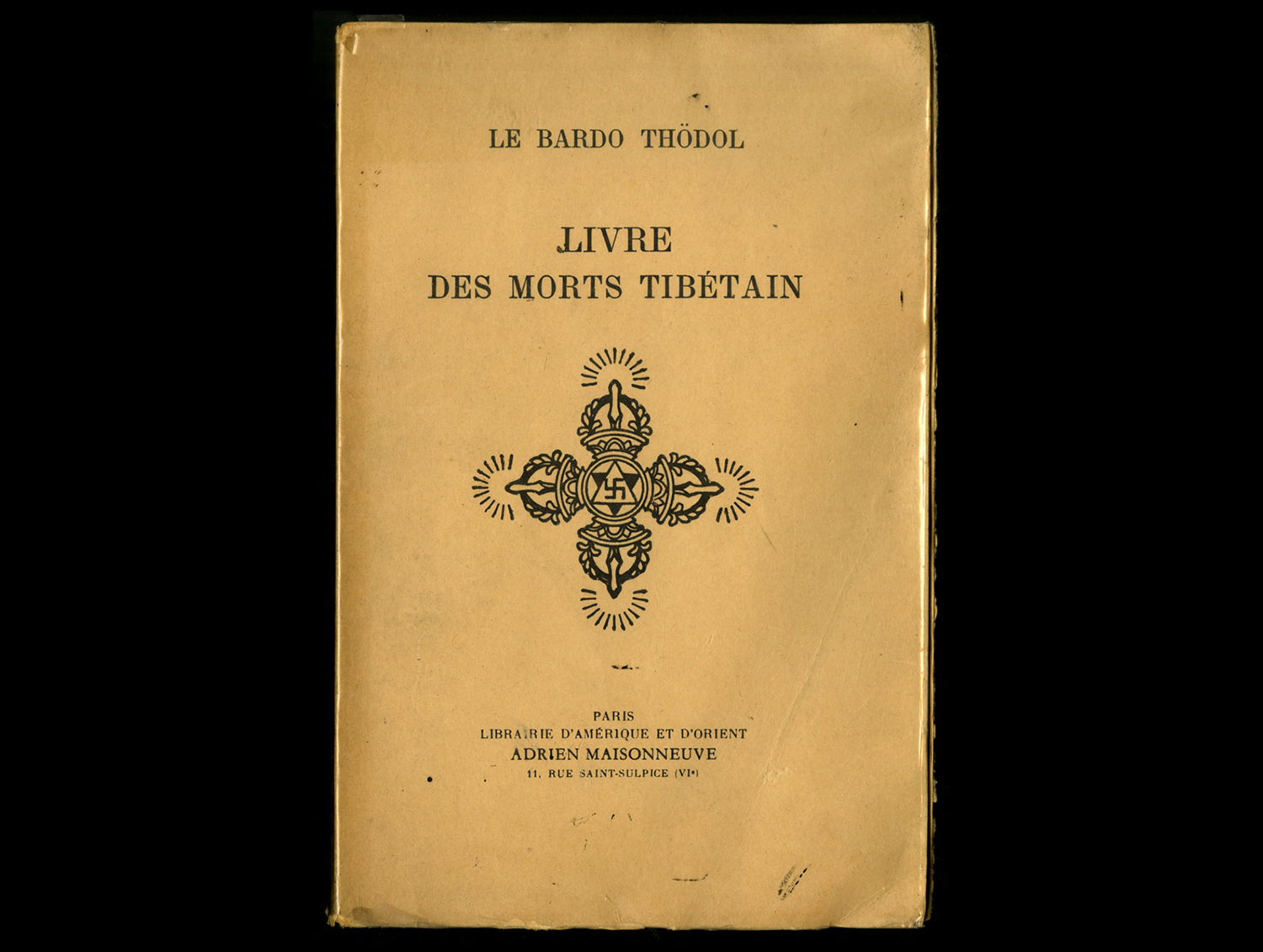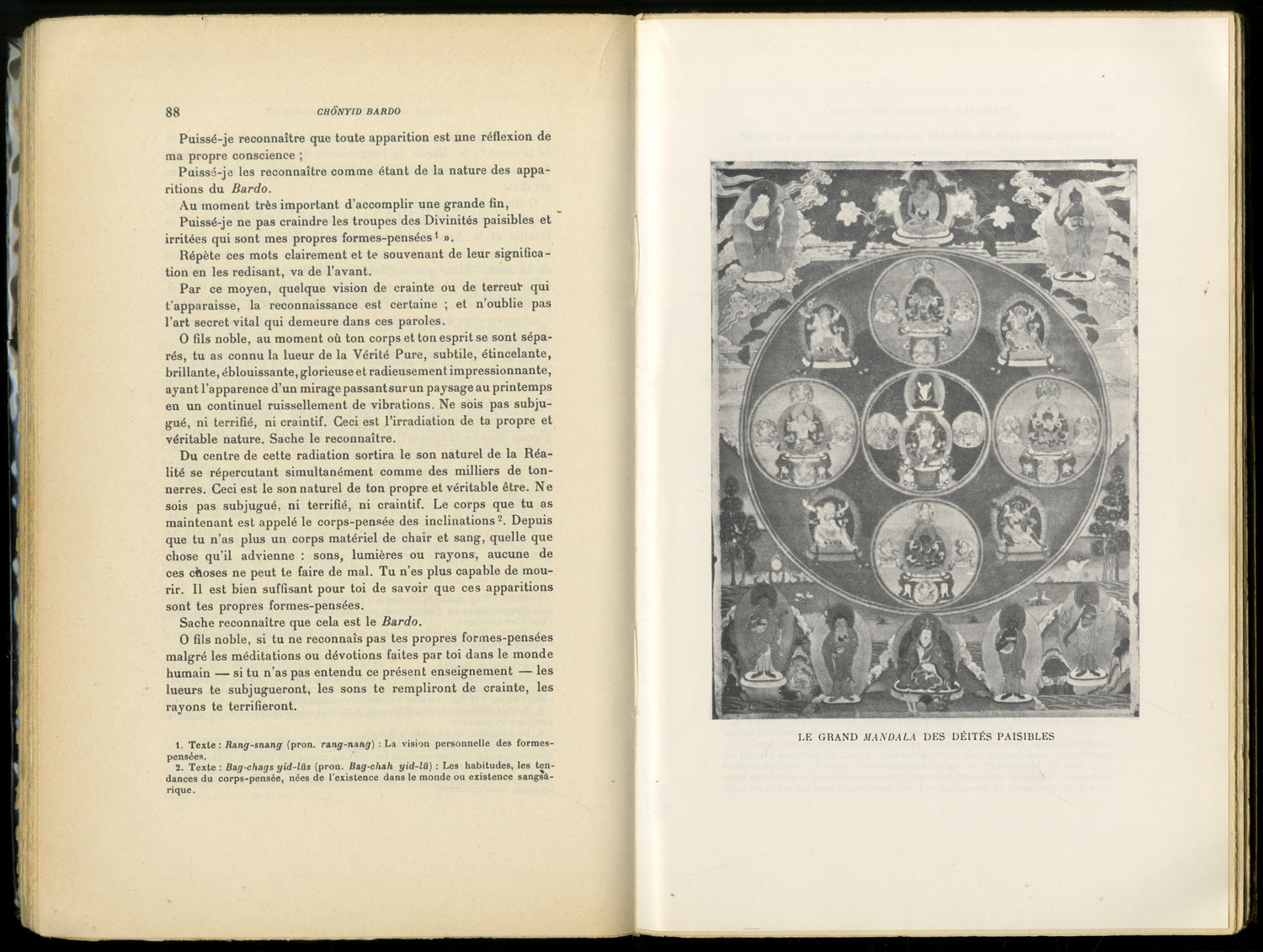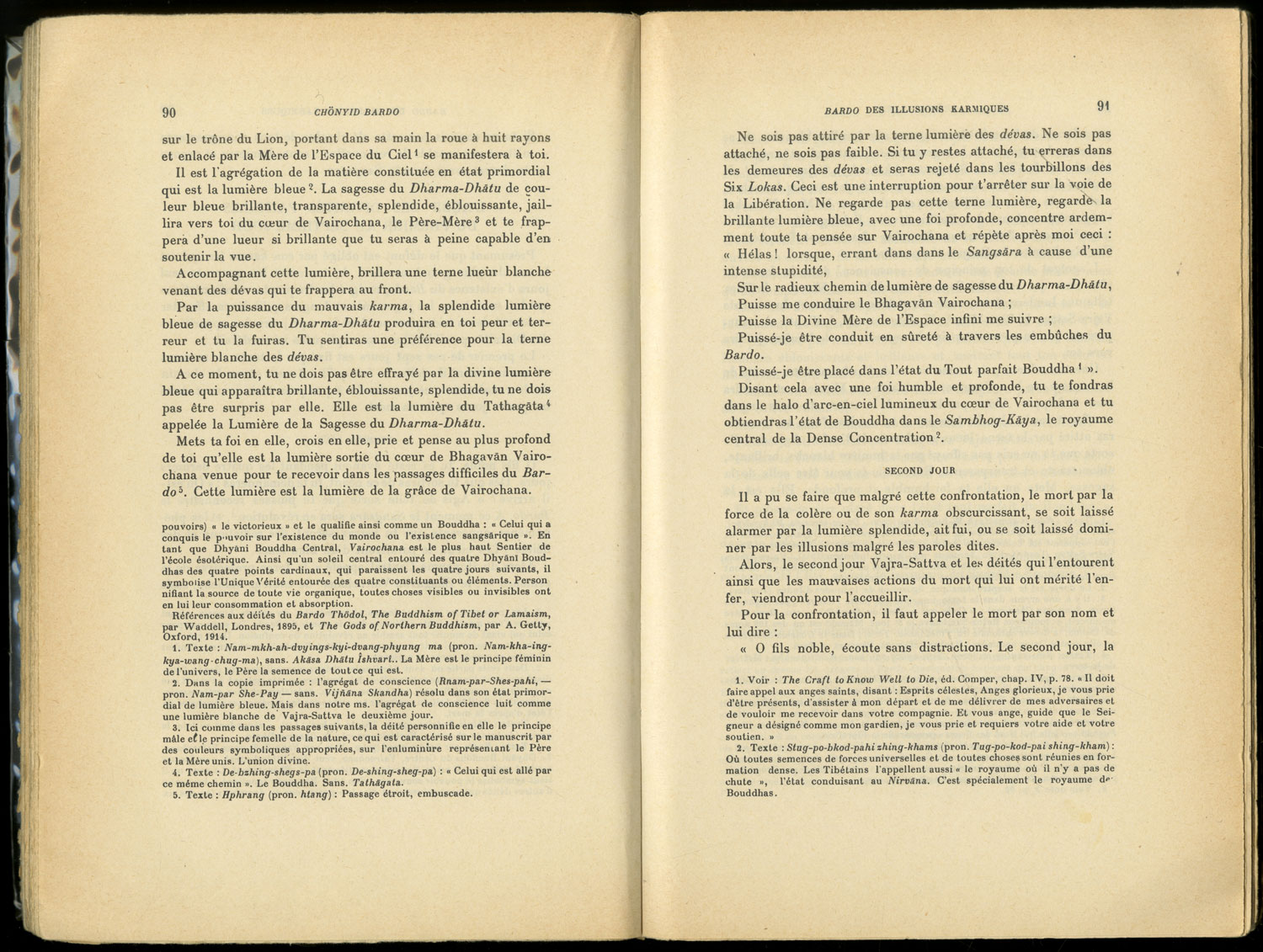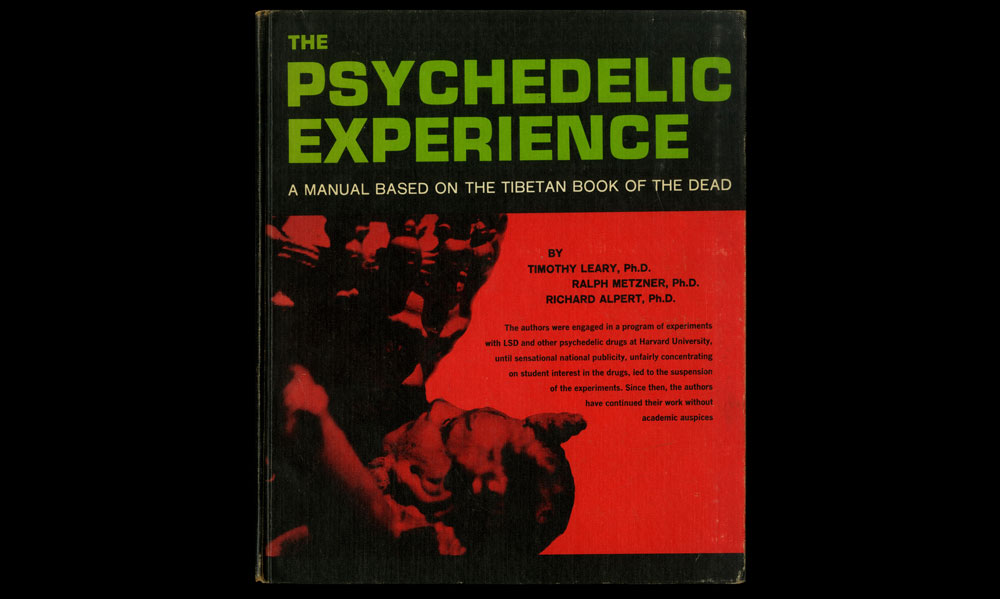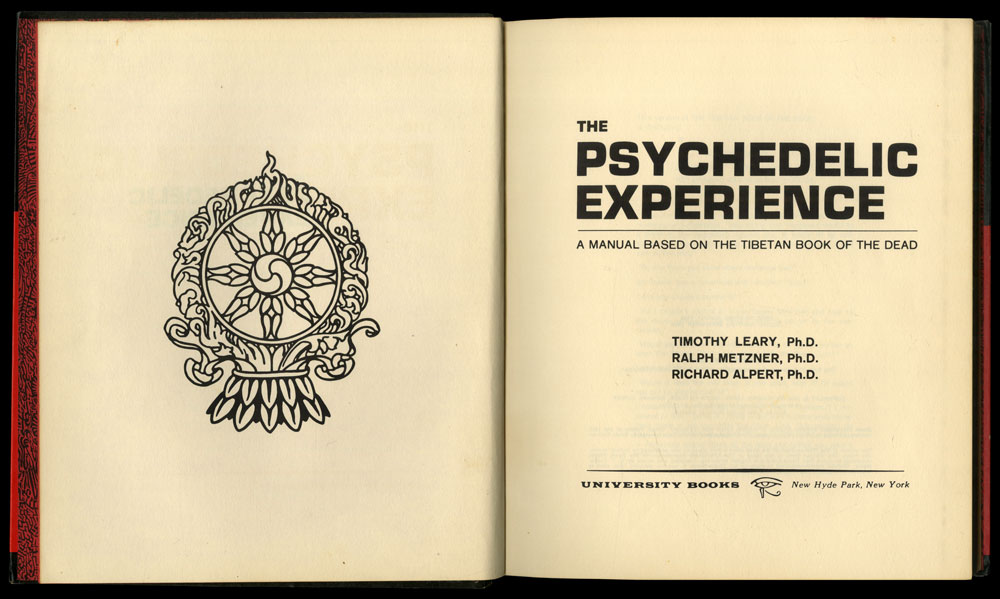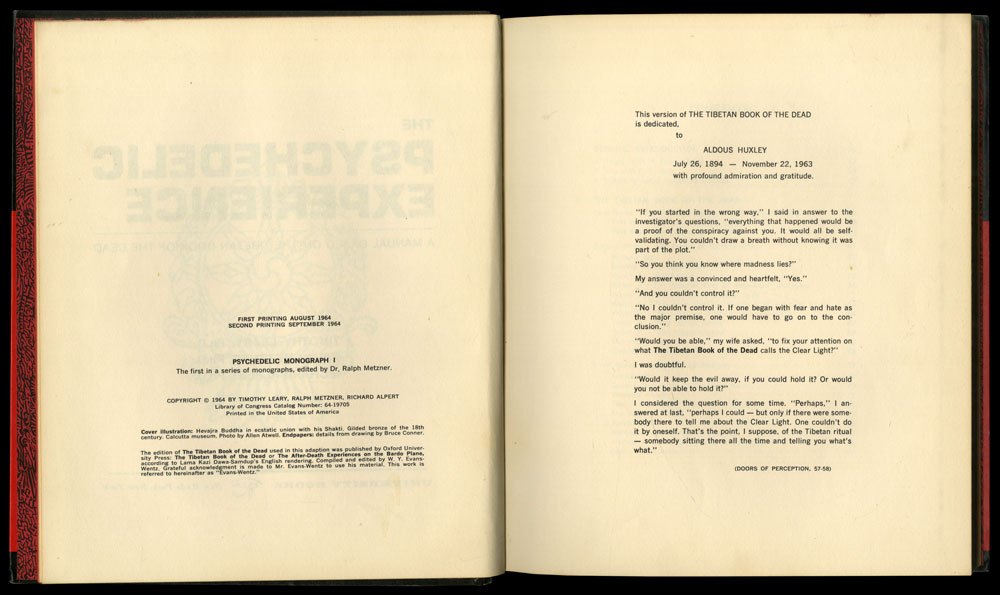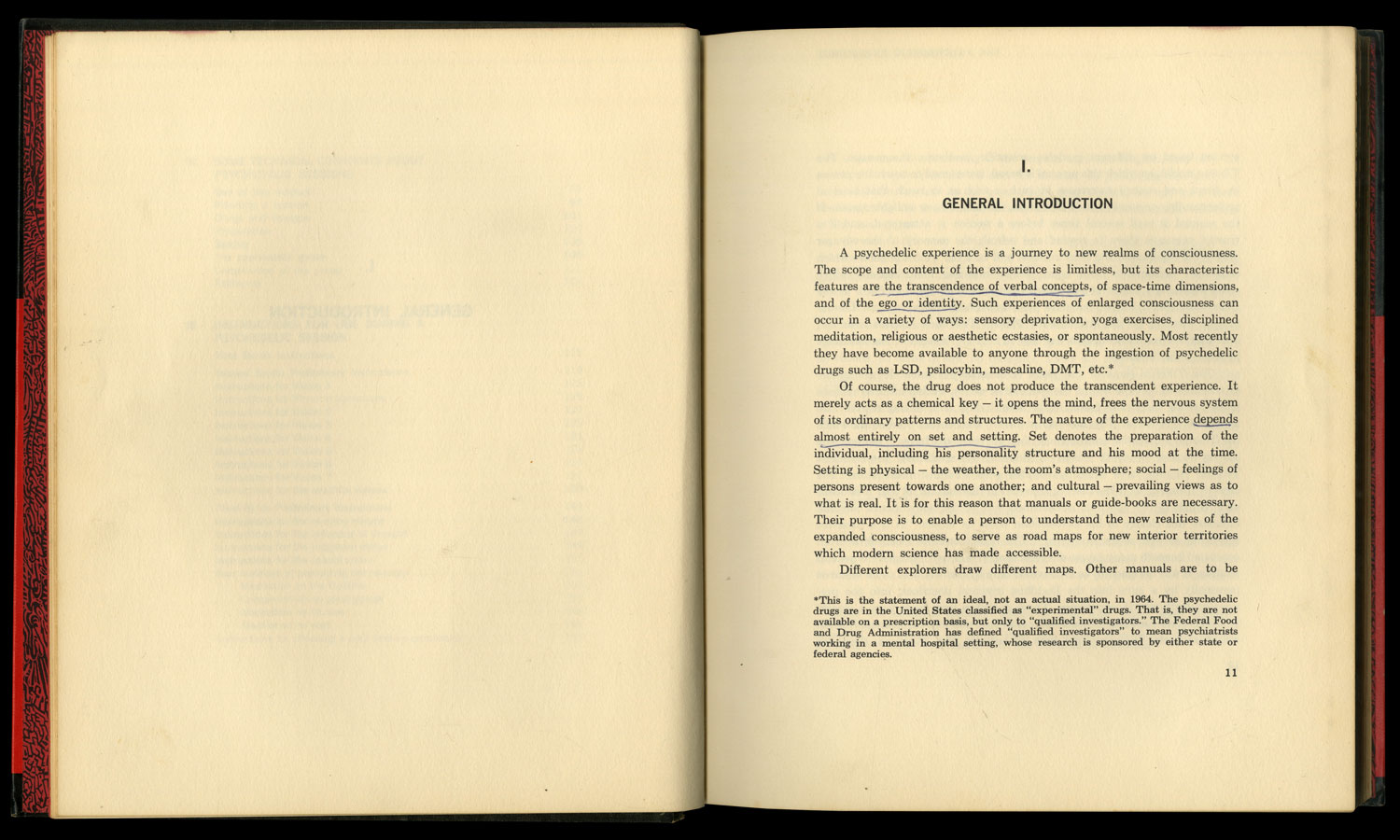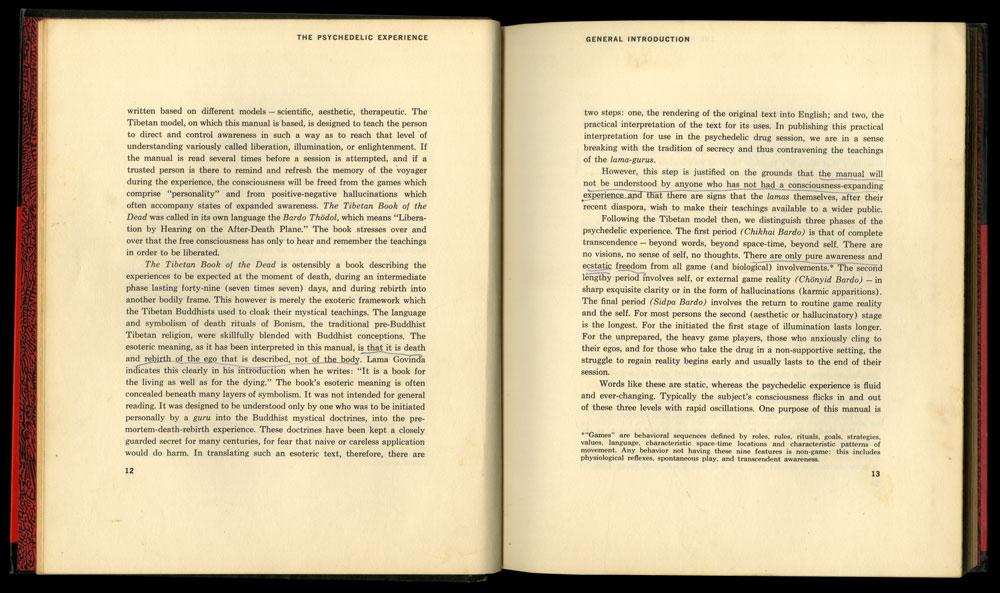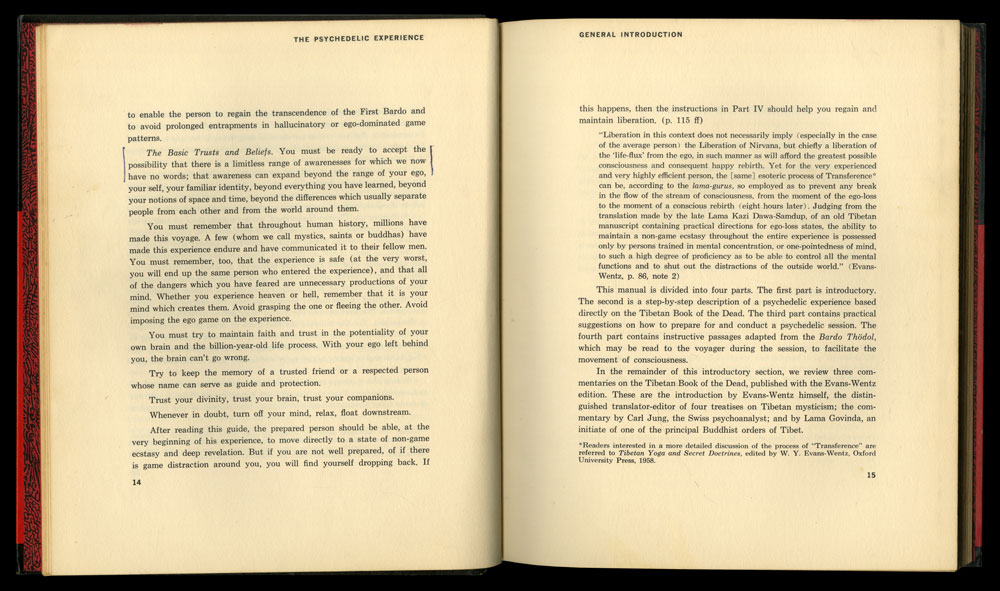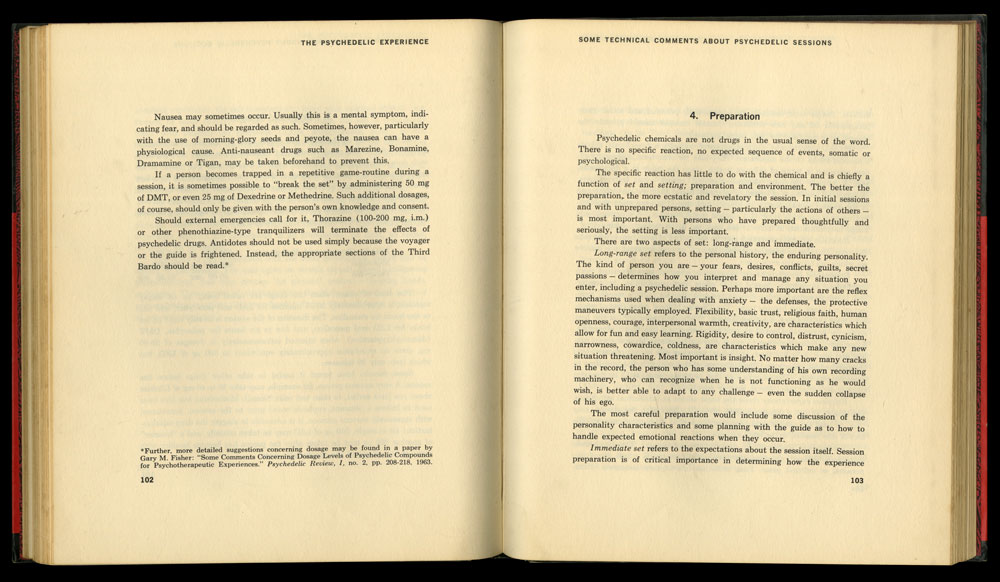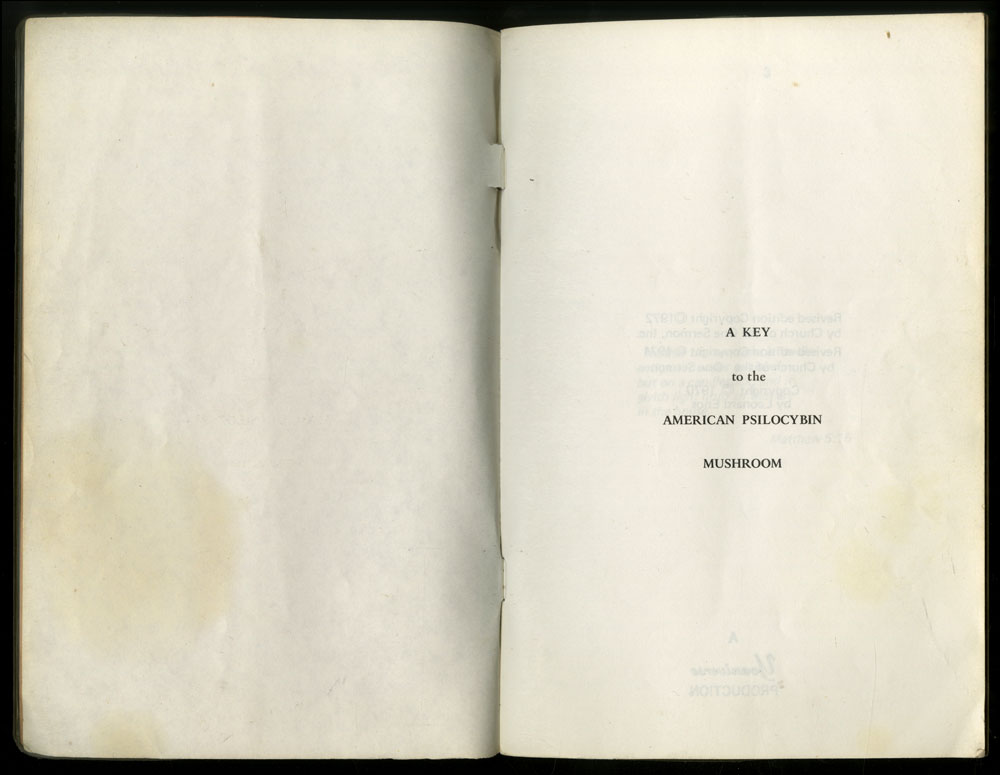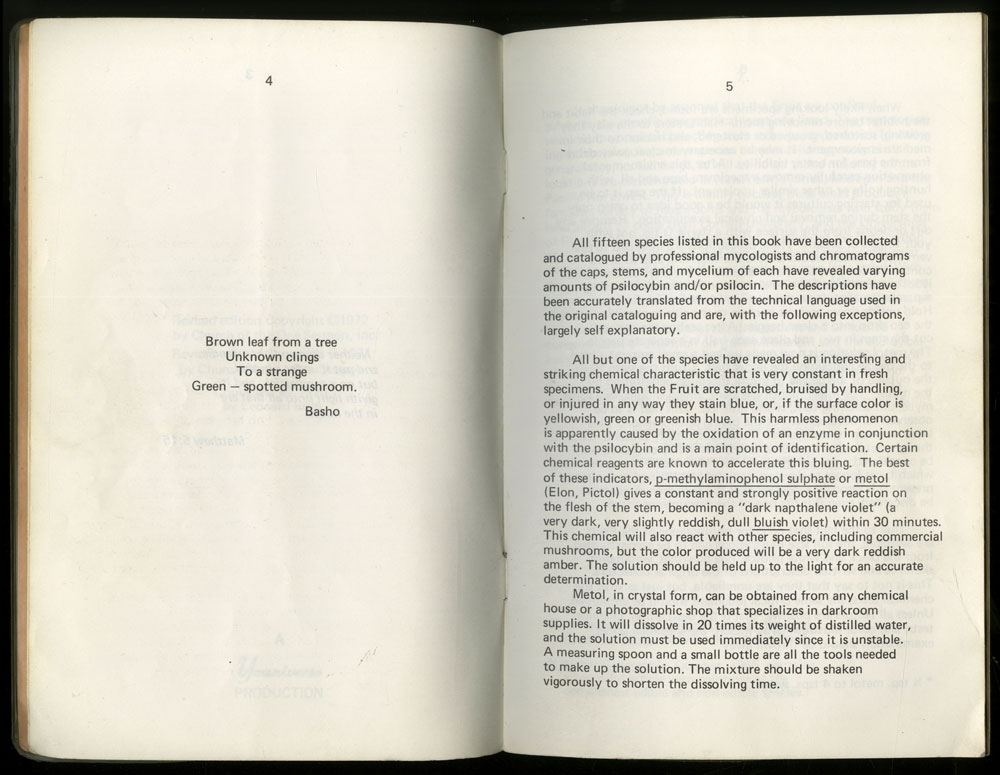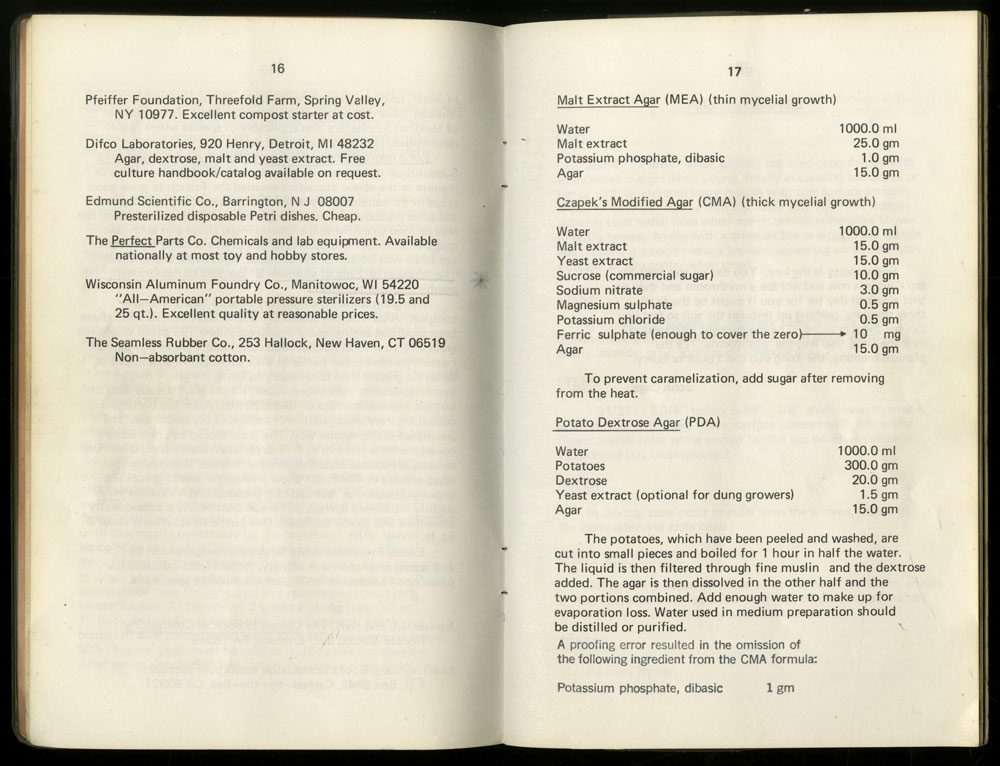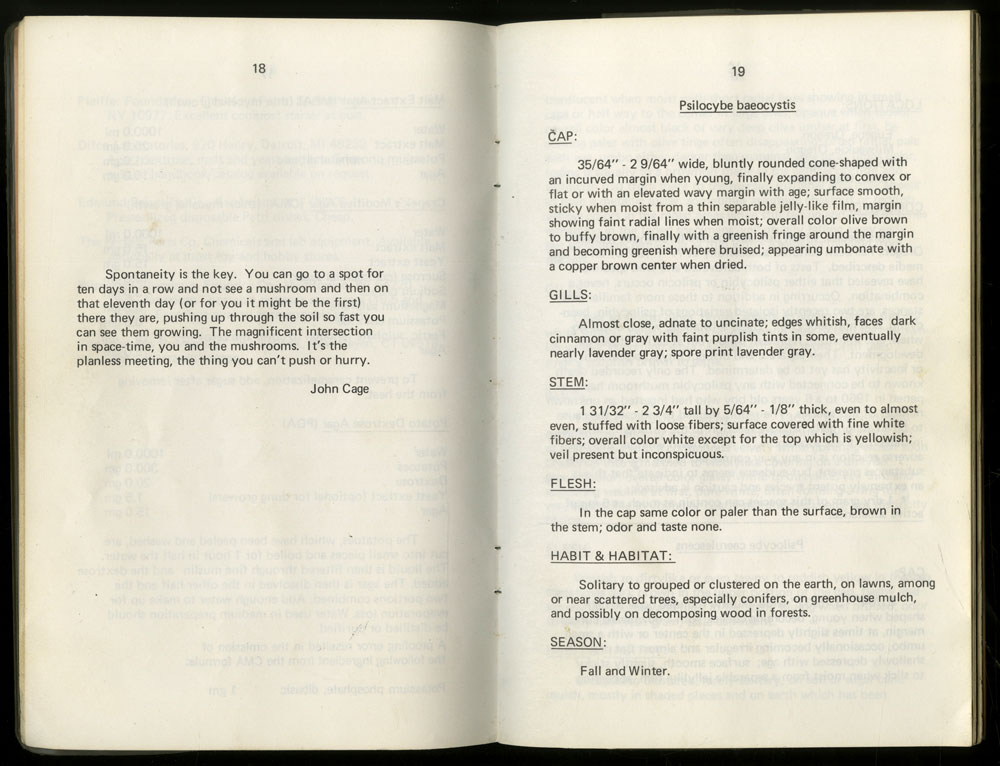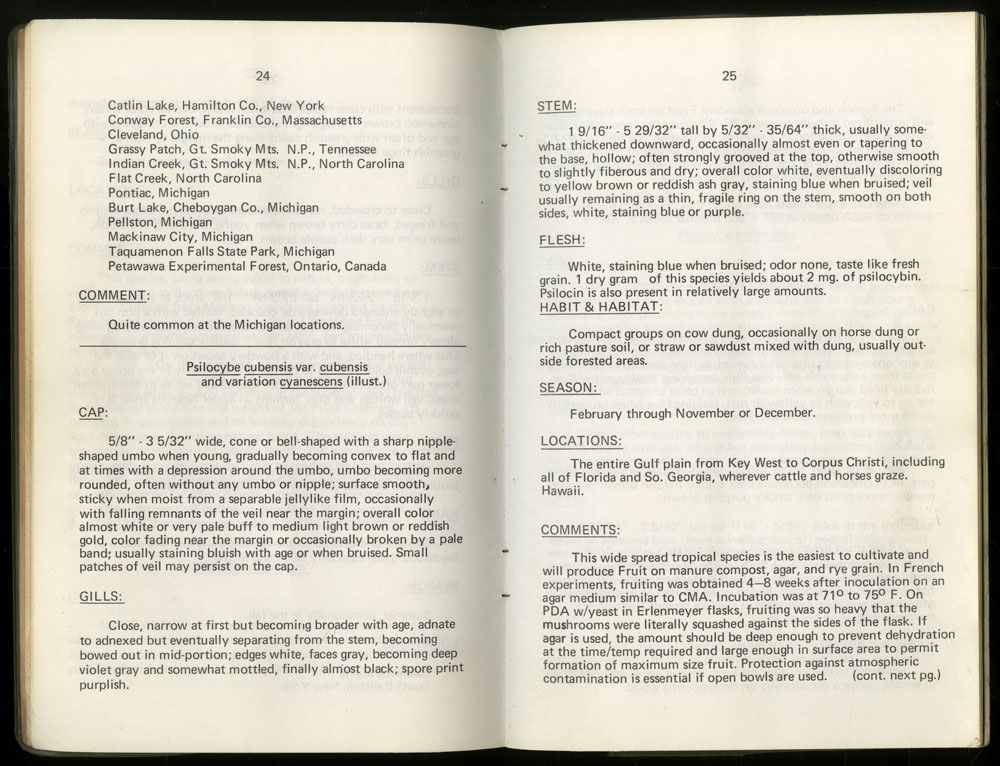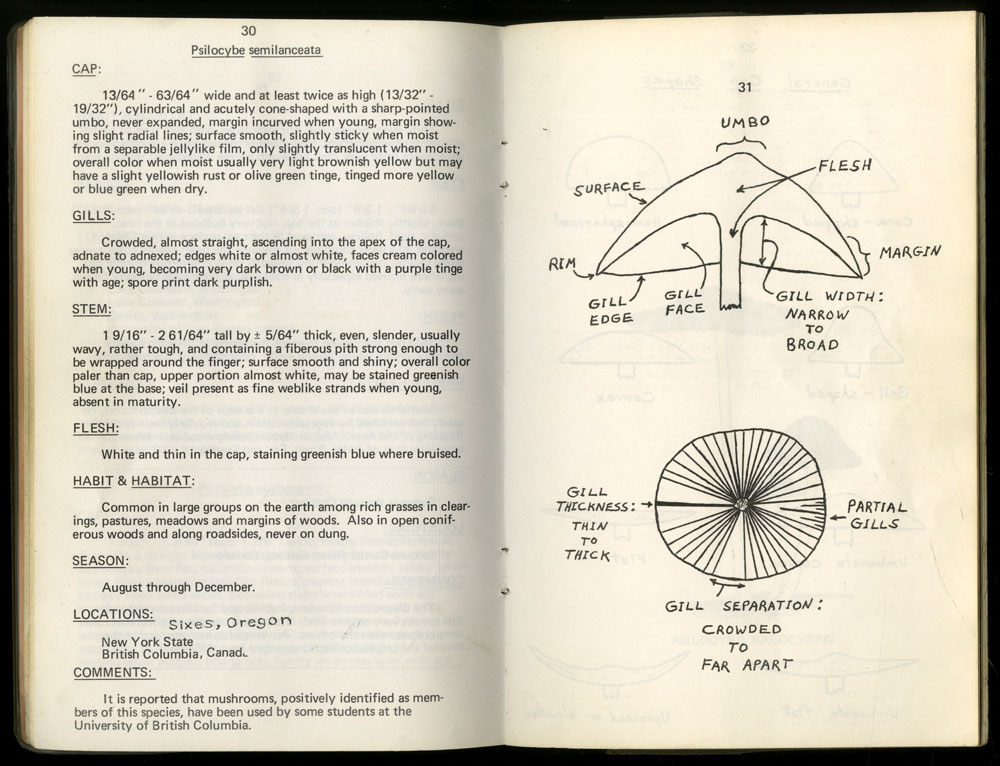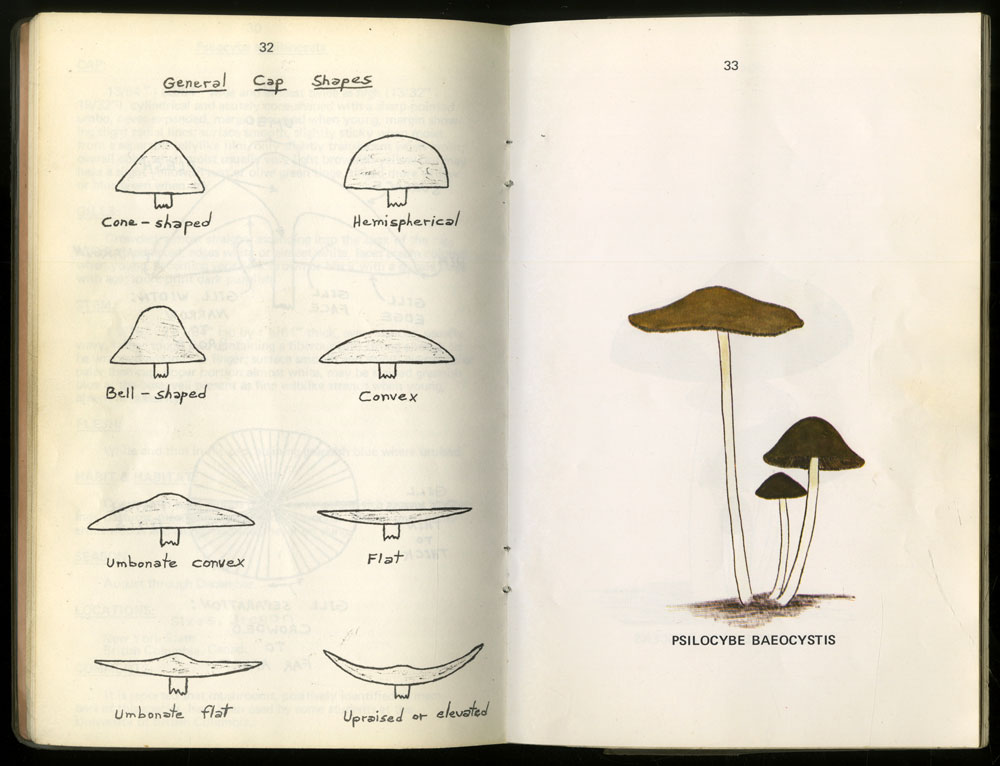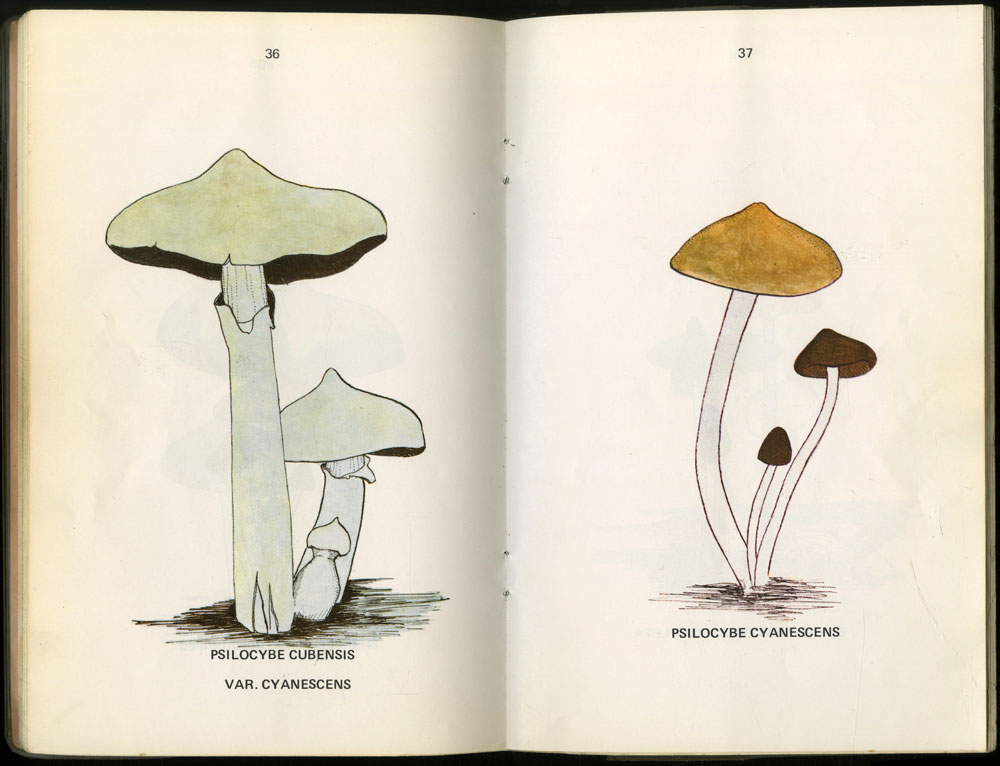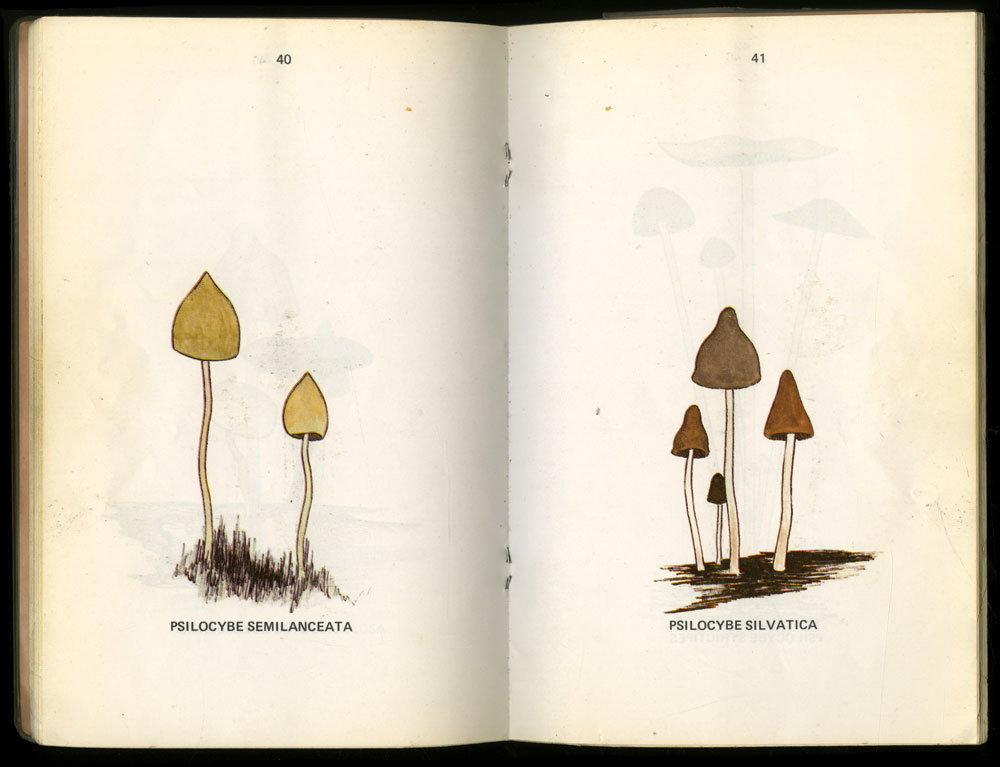
ACID BODHISATTVAMatthieu Visentin
Everyone has the right to freedom of thought, conscience and religion, Article 9 of the European Convention on Human Rights. It appears however that the paradoxical benevolence of the terrestrial authorities forbids any cosmic propulsion by chemical reaction. Here is a mystical collection by which the layman will explore the psychedelic annals; no more no less than a humble door to the unknown realms of the mind.
The books presented in this essay come from my personal collection and thus form an organic exposé of my discoveries.
Original title by Lisa Rein
Supervision by Alexandru Balgiu © ECAL/Matthieu Visentin 2017
ACIDBODHISATTVA
My first encounter with psychedelics took place on reading the famous Doors of Perception by Aldous Huxley, a book of great virtuosity relating the first experiment to which he had lent himself in 1953, by the administration of mescaline, active alkaloid of Peyote, an Indian cactus that produces "colored visions". The doors then opened, I ventured into the fascinating world of psychedelics, the drugs that "reveal the nature of the soul". I recently had the chance to lend myself for the first time to a shattering experience, by ingesting the Psilocybe Semilanceata mushroom.
This essay approaches several major themes such as Reality, Death or the origins of the Universe. Thus, this text might seem like an insolence that will probably raise more than one eyebrow, but it seemed necessary to me, with all the humility of the beginner, to give the reader an overview of the belief system on which this argument is based. To truly grasp the interest of psychotropic use, one must take a step back and observe the great questions to which only the mystical experiences to which mankind has always delved can answer. The aim of this essay is both to advocate a responsible, and centered on the millennial quest of our origins, use of entheogens, and to offer a healthy starting point for the psychonaut in the making. It is also a great opportunity for me to give an intelligible structure to the knowledge I have acquired on this subject and finally to be able to share with my relatives what will change for the best my view of the world, life and beyond: the transsubstantiation of humanity through meditation, contemplation and entheogens. Before actually getting into the subject, it is important to shed light on some terms misunderstood nowadays. Psychedelic is a term invented in 1957 by Dr. Humphry Osmond in one of his correspondences with Aldous Huxley, "To fathom Hell or soar Angelic, just take a pinch of psychedelic." It means "mind-manifesting" - from the Greek psyché (soul) and dēlóô (to show, to make visible). We prefer, however, to use the term entheogenic to designate psychotropic substances inducing altered states of consciousness. This term, invented in 1971 by a group of ethnobotanists, more accurately describes what these substances are when used for transcendental, mystical or ecstatic purpose - from the Greek entheos (inspired, filled with the divine) and genesthai (coming into being).
"To fathom Hell or soar Angelic, just take a pinch of psychedelic" From the Greek psyché (soul) and dēlóô (to show, to make visible).
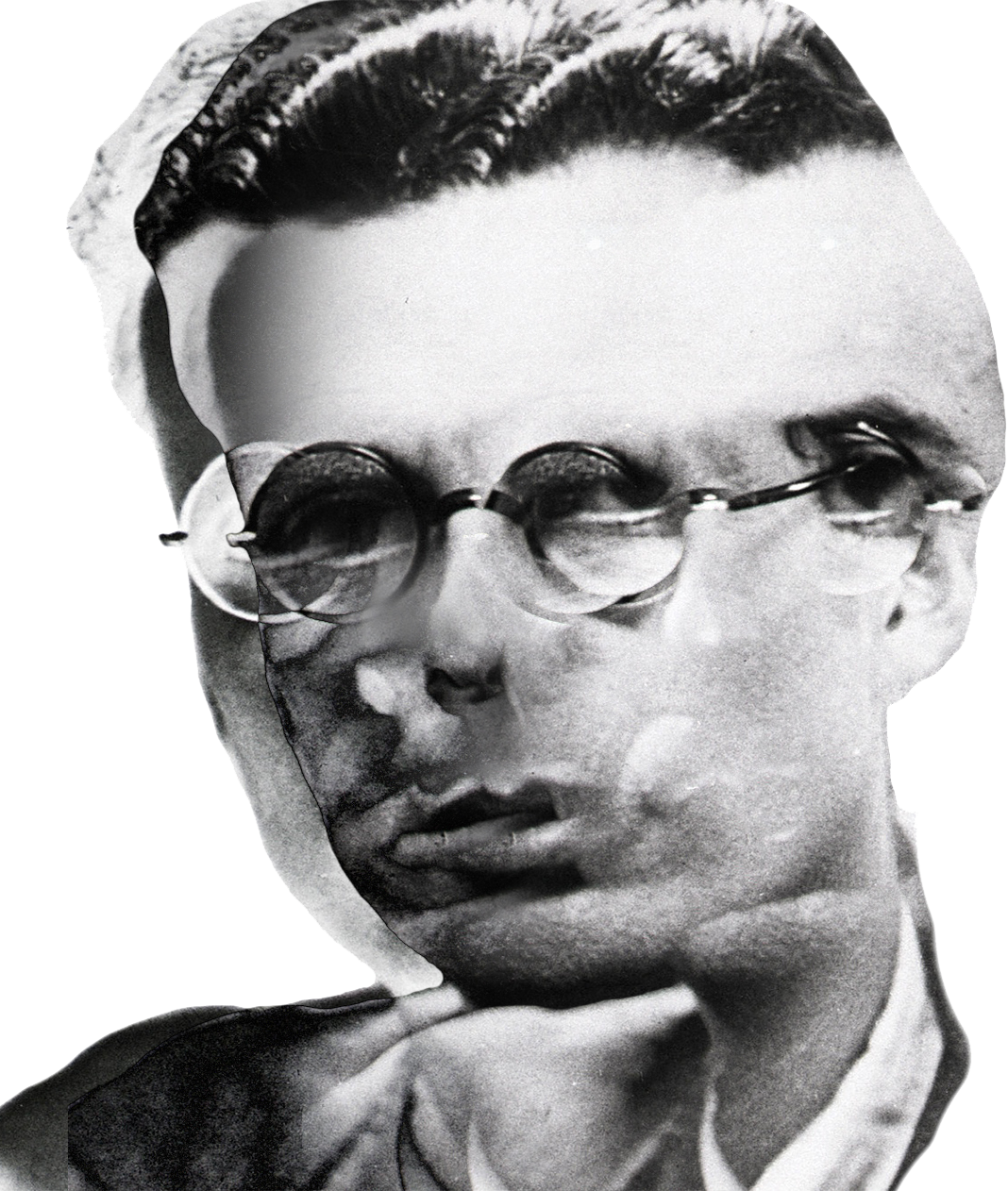
Aldous Huxley (1894–1963), writer famous for his novel of anticipation "A Brave New World", psychonaut at the dawn of the psychedelic era.
UNVEILING REALITY
If […] we are asked by what right we are talking here about a reality that transcends the world and touches us, we can only answer: what more real experience man can live than that which delivers him at one stroke from the fear of death, despair at absurd and sadness in solitude and allows him to live, within the misery of the world, the happiness of a supra-terrestrial dimension?
The self is like a jungle. It is an inextricable network of branches and vines which grows and thickens from year to year. Every experience, banal or exceptional, every memory, trait of character, ambition, belief… is another vegetable in the jungle of the ego. The denser the vegetation, the more it obscures what we really are. The self is what we are on the surface and think we are in depth. It participates in what we define as reality. The self is stimulated by what is external to us, through senses, objective and rational concepts, and is easily distracted. It acts both as a stingy valve and as an anchor firmly attached to a world governed by reason and logic. The more frequent the external stimuli, the more vines of our self tighten their grip on our existences. It seems that at a time when the sources of distractions are jostling for our insatiable hunger for entertainment, our personal jungles are somewhat overflowing and more than ever hermetic to any other form of reality. Let us emphasize on what distractions imply. In our society plagued by martial, financial and identity crises, entertainment is understood as a beneficial activity that allows us to relax from external pressures for a while. "The contemplatives have compared distractions to dust, to swarms of flies, to the movements of a monkey stung by a scorpion. Still, their metaphors evoke the image of a pointless agitation. [...] To realize how much they can be empty of purpose and incoherent, one just have to sit back and try to collect himself. The preoccupations connected with the passions will probably come to the surface of consciousness, but with them will rise an oscillating foam of memories, vague ideas and imaginations, mingled with hazard. [...] That is why all advanced spiritualists have attached so much importance to these imbecilities and put them to the rank of sins." Aldous Huxley On Distractions in "The Doors of Perception" 1954 What must be understood here is that distractions are barriers between the soul and the ultimate reality. All that physical reality has to offer us participates in our rootedness in this one and only tangible dimension. It is not a question of acting in the fear of a judgement as Christian morality teaches us for several millennia, but rather of realizing that the more we embrace this world, the more we move away from our nature within. It is no coincidence that religious feeling has virtually no place in the West. It is even less surprising to see the disarray of many people in the face of death, the meaning of life or the place of humankind in the Universe. Without spiritual inclination, such despair can not be overcome. Neither science nor politics, let alone the economy, can offer answers to such essential questions. There is no question here of judging this mode of existence. Everyone does not have the same ease for the search for an "Elsewhere". It is more a question of realizing that there is not only one form of reality, but that our consciousness – through methods developed since the dawn of time – has the ability to move from one dimension to another. One will declare that we seek to escape our responsibilities or to escape from the suffering of human existence. It is not a question of escaping, but of exploring what our straight mind can not understand. Awakening to reality in its entirety. Once the reality of this world is transcended, it becomes evident that what is considered reality is an illusion. Here is what Karlfried Graf Dürckheim, an eminent German psychotherapist and practitioner of Kyudo, tells us about reality: "If […] we are asked by what right we are talking here about a reality that transcends the world and touches us, we can only answer: what more real experience man can live than that which delivers him at one stroke from the fear of death, despair at absurd and sadness in solitude and allows him to live, within the misery of the world, the happiness of a supra-terrestrial dimension?" Karlfried Graf Dürckheim "L'Expérience de la Transcendance" 1994, Albin Michel, translated from the French We take a human form at our birth in order to live a whole series of experiences likely to make us aware of the illusion. The illusion that we are exclusively separated from the totality of the world of forms, or what we might call God or the world of non-forms that is beyond the world of forms. The journey of Awakening makes us realize that the reality in which we have grown, the reality as inculcated by our parents, is only relatively real. We then become aware that there is more than one reality. Not only on the intercultural level, but also on the different levels of consciousness. The reason why these other dimensions are accessible to us only in fleeting occasions is brilliantly exposed to us by Aldous Huxley. "In order to make a biological survival possible, the mind must by dug by piping through the reduction valve constituted by the brain and the nervous system. What comes out at the other end is a parsimonious draining of this kind of consciousness that will help us stay alive on the surface of this planet…"

Illustration of Gary Grimshaw from the american activist newspaper WIN of February 1971.
THE MYSTERY
At the highest esoteric level of every spiritual religion, there is a common quality: the numinous. It is the profound sense of the absolute, divine presence of an Elsewhere, which relates chiefly to the plane of the mind and transcends understanding. Carl G. Jung describes this quality very accurately. "The reality which manifests and experiences itself as the quality of the Numinous is the very foundation of all religions. […] Is not this reality, common to all religions, the true nucleus of all religious representations?" All forms of divinity, whether manifold as Hindu or unique, as well as among Christians, are the expressions of the ways that humanity has developed in the course of its evolution in order to arrive at a perfect understanding of the Universe. These symbolic representations are for the non-regenerated man the crumbs of bread by which he has the opportunity not to get lost in the meanders of his own inner jungle and the external world. They do not allow a union with our deep and original Being, but bring us keys to the realization of this union. Thus, Buddha is not to be considered as a historical figure. It is above all the name given to an extremely profound state of consciousness which has manifested itself on several occasions during the course of history, in individuals today venerated. Concealed behind history and anthropomorphic representations, the most enlightened of ancient times have thus offered the layman an image of perfection, a model for the millennia to come. It is the same with Christ, Krishna and probably as much for Mohammed. These finished images, humanized, characterized are an absolute necessity for the transmission to the greatest number of the message of which they are the ambassadors. But just as verbal language is extremely limited in its capacity to express the profound experiences of which we are sometimes subject, these authoritarian figures do not allow a perfect understanding of what man can aspire to. They are often very poorly understood, distorted or exaggerated over generations. Each religious movement, through a messiah or a great holy founder, thus transmit as many values, moral judgements as paths to the total regeneration of man. These mysteries are kept under the seven seals of silence by mystics of all religious schools.

"Buddhist Ideals" is a scarce study in comparative religions edited in 1912.
Every religion is built on mystery. These mysteries have always been accessible only to the initiates, to the mystics. They are the holders, through unwavering devotion, of a knowledge by which it is possible to attain an absolute completeness of self. Mystical literature is nowadays rich in decrypted mysteries. It is a real gift that authors such as Walter Evans-Wentz, Aurobindo Ghose or Alan Watts offer to humanity. It is also a wound because a mystery unveiled, concrete answers to the great questions are not satisfactory for the non-regenerated man. Indeed, as soon as the mystery is exposed, there is no one left to take it seriously. How can excessively simple assertions be sufficient to answer the meaning of life, our origins or the question of life after death? This very simple revelation appeared to me during reflections under psychotropic influence: behind the symbolism and all the complexity of the mystical teachings there are almost always hidden concepts that are exceedingly simple. It is because these naked truths are this simple that it is necessary to make them mysterious in the eyes of the layman. What impact and longevity would have a childish teaching that requires no reflection? The answers to the most existential questions are of outrageous simplicity.
How can excessively simple assertions be sufficient to answer the meaning of life, our origins or the question of life after death?
ENTER THE VOID
"Thirty rays converge at the hub but it is the median void which operates the chariot. The clay is shaped into vases but it is of their internal void that their use depends. A house is pierced with doors and windows it is still the void which allows its habitat." - Lao-tzu, Tao Te Ching
Since man is capable of observing matter on the atomic scale, we have the certainty of being essentially formed of void. If the void contained in the atoms of the human body were removed and only the electrons and other subatomic particles were left, humanity could be contained in a sugar cube. What is to be learned from this lesson is the importance of void. It is not a frightening void in which nothing exists. It is from it that all things take their form. Void is what unites everything. The essence of our existence, the pure and intangible energy that inhabits us, is empty. This energy has no will of its own. It is moved by the perpetual flow of the Everything. It is part of the Everything. It is Everything. Lao-tseu calls it Tao, Christians call it God, the Buddhists call it Vacuity. When the bodhisattva has freed himself from the terrestrial chains and attained enlightenment, he realizes then that he is not a body separate from the rest. The veil falls and the illusion of reality collapses completely. Everything is energy, everything is one. It is at this moment that what the Hindus call the abandonment of the body occurs. We call it ego dissolution. It is the total loss of subjective identity, a separation between the mind and what defines us in the physical world. All the barriers that separated all bodies and all matter then fall. There is no more personality, no more individuality. It is a cosmic journey beyond the understanding. The death of the ego is the key to reach this profound reality. Everything is complete synergy and chaos at the same time. What we call our soul finally frees itself from the limits of consciousness and offers the traveler a glimpse of what has hitherto been hidden from him. The perfect unity of all that lives, of all that is visible and invisible, of the tangible and the intangible, the intelligible and the absurd. The Great Liberation is the absence of conceptual mental activity in the nervous system. The realization of the absolute void, the unbecome, the unborn, the unmade, the unformed, the perfect Buddhahood. This ancient concept of total emptiness and perfect unity of Everything joins the point of view of the theoretical physicist George Gamow. If we went back in time, we would inevitably arrive at the "Big Squeeze" of the galaxies, atoms and all matter. Aristotle had named the resulting fundamental substance "Ylem". At this point in the evolution of the current cycle, according to Gamow, there existed only the unbecome, the unborn. And this is how everything will end: the silent unity of the unformed. Tibetan Buddhists suggest that the completely purified intellect can experience this total unity. Among the Aborigines of Australia, we speak of the Dream Time. This period is considered preceding directly to the creation of the Earth and of what lives there. An abstract time when everything was spiritual and immaterial. Even matter was non-existent. According to aboriginal beliefs, the Dream Time can be achieved. Thus, as with many religions, methods have been developed to reach higher levels of consciousness, and to touch the very foundations of Creation."It is by severe self-discipline and a humble and tirelessly repeated action that man becomes gradually permeable to the living Essence of all things in the unconscious depths of his individual self and prepares himself for the 'Great Union'."Karlfried Graf Dürckheim "L’Expérience de la Transcendance" 1994, Albin Michel, translated from the French Enlightenment, Samādhi, the Kingdom of Heaven, whatever the term one gives to the elevation of the consciousness towards the perfect union of Everything, is accessible only to whom which consecrates his existence at its meeting.
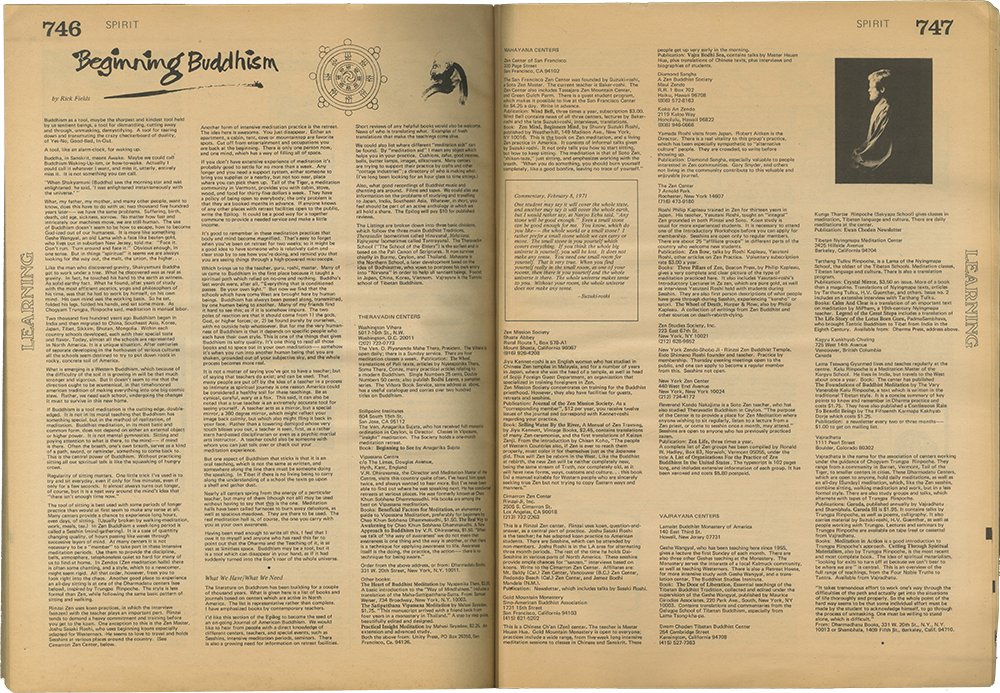
Spread of the "Whole Earth Catalog" of 1974, displaying informations on Buddhism and the main bouddhist centres in North America.
THE ULTIMATE FRONTIER
To-day one is exceedingly frightened by the moment of his death. It is, however, a natural and perfectly inevitable phenomenon, in the same way as birth, youth, adulthood and old age. For several millennia, Western man has sought methods to prolong his biological existence, even to reach immortality. This is a vain quest. While the scientist seeks to make the physical body survive by the limited means of science, the bodhisattva detaches himself in order to sublimate his substance and free himself from the perpetual cycle of incarnations. Hinduism teaches us that the soul is, and can not cease to be. Although it can change the forms through which it appears. This opposition between being and non-being, that balance of being and becoming which is the mental conception of existence, ends when we realize that the soul is the only imperishable self through which was 'extended' all this Universe. Here is an excerpt from the Bhagavad-Gîtâ, one of the key texts of Hinduism: "The incarnate soul rejects the old bodies and clothes itself with new ones, just as a man exchanges a used garment for a new one. The arms can not slay it, nor the fire consume it, nor the waters penetrate it, nor the wind dry it out. It can not be suppressed, it can not be burnt, it can not get wet or be dried. Stable eternally, motionless, penetrating everything, it is forever and ever. It is unmanifested; it unthinkable; it is immutable; thus it is described; therefore, knowing it so, you ought not to be afflicted [with suffering, joys and death].""Bhagavad-Gîtâ" 1947, Éditions Albin Michel, translated from the French The great Indian sage Sri Aurobindo, in his profound study, teaches us that "the constant subjection too birth and death is an inevitable circumstance of the self-manifestation of the soul. Its birth is an apparition out of a state in which it is, not non-existent, but non-manifested to our mortal senses; its death is a return to this world or this condition of non-manifestation, from which it will emerge again in physical manifestation. The agitation of the physical mind and the senses about death and horror of death – in bed or on the battelfield – is the most ignorant of nervous screams."
The teachings of Buddhism about death, particularly evident in its Tibetan practice, are almost identical to those of Hinduism. Here, too, the soul or the ontological substance is unalterable and immortal. It is non-manifested and elusive. It is through the Bardo Thödol (or Tibetan Book of the Dead) – one of the most important texts of Mahayana Buddhism – that we learn with extraordinary precision what happens at the moment of death. One could believe that this science was acquired by men who had returned from the threshold of death, but the theory proposed by Dr. Evans-Wentz (author of the first western translation of the Bardo Thödol in 1954) seems more likely. According to him, it was dictated by great masters, attentive agonists, who had the strength to teach to their disciples the process of their own end. However, the mystery remains. Indeed, the Book of the Dead goes further. After having addressed the dying man, the teacher in charge of reciting it directs the spirit of the dead through the so-called intermediate state – the Bardo – between death and rebirth. It has been decided here to present only these two systems of thought – by personal affinity and willingness to present the most flagrant examples – but it is evident that the eschatological sciences that are based on the idea that every living being is endowed with an immortal soul are legion across the globe. It appears that we are, in essence, immortal. However, it is impossible for us to realize our immortality if we do not reach enlightenment in the course of our earthly life. It is to this end, mainly, that the continuation of this essay proposes an extremely ancient yoga (discipline), disappeared in the millennia and then revived since the second half of the twentieth century: the psychedelic experience.
O noble son, the time has come for you to seek the Path. Your breath will stop. Your Guru placed you face to face with the Clear Light. And now you are going to know it in its Reality, in the state of the Bardo, where all things are like the empty and cloudless sky, and where the naked and spotless intelligence is like a transparent vacuity without circumference or center. At that moment, know yourself and stay in this state. – Bardo Thödol
ENTHEOGENS
Probably discovered accidentally several million years ago, entheogens have always been part of the cultures of all the continents. These are psychotropic substances inducing altered states of consciousness. These active products are present in a large number of plants and fungi. They are used in religious, spiritual or shamanic practices. Deviated from their traditional and spiritual use, these substances which have suffered in more that 50 years irresponsible and recreational consumption are now illegal in practically all the countries of the globe. Entheogens are represented in 5 groups: 1. The lysergic acid derivatives – present the ergot of rye – of which LSD is the best known 2. The derivatives of phenylethylamines, of which mescaline, present in particular in peyote, is an example 3. Derivatives of tryptamines such as psilocybin present in fungi of the Psilocybe genus 4. Derivatives of piperidyl benzilate of which JB 329, or Ditran, is an example 5. Phencyclidine or PCP In his revolutionary thesis Food of the Gods, the philosopher Terence McKenna proposes a bold theory on the development of consciousness in early men several million years ago. According to him, when the African forests would have greatly receded to make way for the prairies, the great apes would have begun to migrate towards them, discovering then a new way of life. Feeding previously mainly with fruits and small animals, the first men learned to hunt until they met the peaceful ungulates including cattle. Living near these animals, they discovered a tasty food that grows in their manure and lands fertilized by their passage, mushrooms of the psilocybe type. According to McKenna’s theory, the consumption of these mushrooms would have triggered a new phase in the evolution of humanity through the development of self-awareness. Whether one takes this approach seriously or not, there is a curious connection between this thesis and a famous passage in Genesis. What he seeks to demonstrate above all is the symbiotic relationship between man and psychotropic plants. We are naturally constituted to consume these substances and receive their teachings. In order to go deeper into this statement, we have a lot of scientific data.
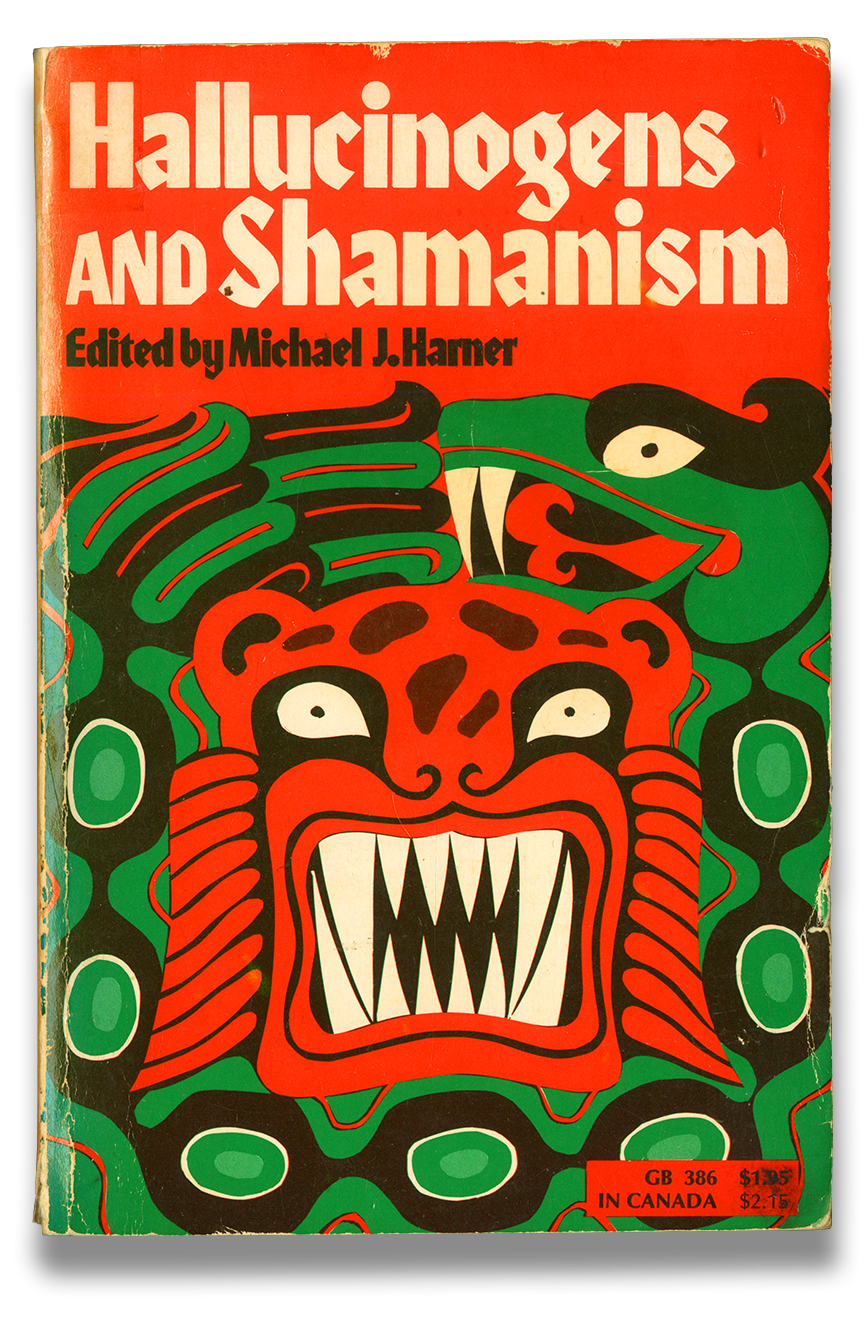
"Hallucinogens and Shamanism" (1973) is an exciting collection of articles written by conscientious anthropologists and ethnobotanists about shamanic practices in South America.
Take the example of cannabis. The parts of this plant that have always been consumed contain a resin composed of active substances such as THC (thetrahydrocannabinol) and CBD (Cannabidiol). These are substances that belong to the group of cannabinoids. Now, it happens that the central nervous system of man is equipped with receptors called endocannabinoids (CB1). The latter react to cannabis by the euphoric and calming effects that are known. Our immune system is also equipped with receptors (CB2) responsible for anti-inflammatory effects and other possible therapeutic effects of cannabis. Let us now take the case of DMT (N,N-dimethyltryptamine). It is the most powerful psychedelic known to date, and is one of the most ancient substances consumed. It is in the tribes of South America that we still find living shamanic practices. The shaman is healing by magic. A magic from the plants and the inspiration that they give him. The now famous Ayahuasca preparation is their great ambassador. It consists of two plants, the bark of Banisteriopsis and its activator Psychotria Viridis. The combination of these two plants produces a certain amount of DMT in the beverage. It is impossible to ascertain since when this infusion is consumed, because of the savage destructions of the conquistadors, but traces of its use have been found in the Aztecs. Again, it seems that we are naturally equipped to receive this substance. Its chemical structure is very close to the serotonin, secreted by our nervous system. Some scientist propose a theory that near death experiences would be caused by the production of DMT in the pineal gland. It is important to understand that these substances do not produce transcendental experiences. They act as a key opening the doors of perception. They open the mind and free the nervous system from its normal functioning and structure. Everything that is perceived in a psychedelic experience is produced by the mind, freed from its biological chains. The reduction valve that is the brain opens completely, pouring out a torrent of perceptions and unheard-of concepts. The traveler is then immersed in a new unfiltered reality. It has recently been demonstrated by magnetic resonance imaging that under the influence of LSD, regions of the brain that never communicate with each other create new networks and result in almost complete communication between almost all areas of the brain. The images perceived by the traveler under LSD are therefore not exclusively produced by the visual cortex, but also by areas dedicated to other tasks.
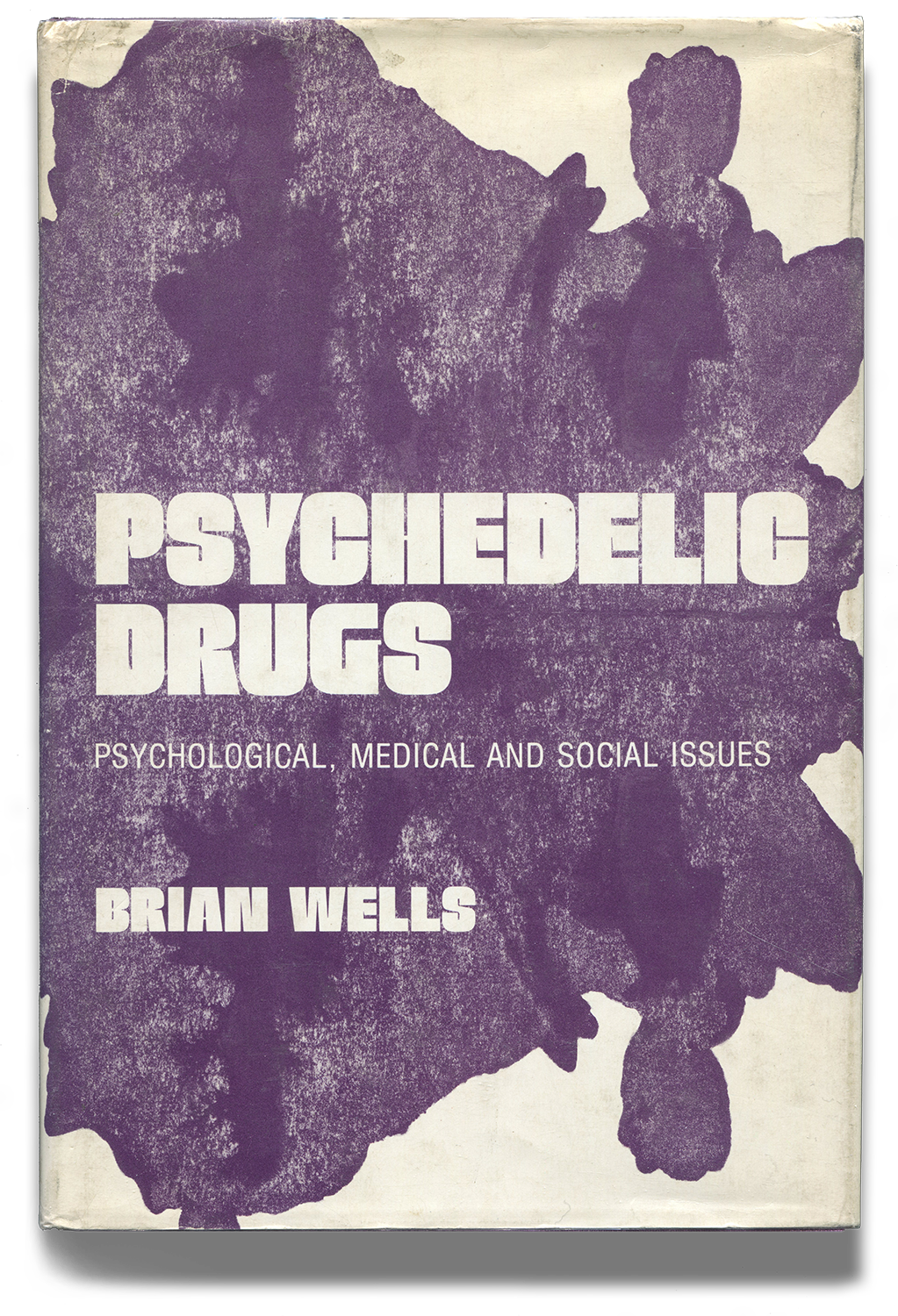
"Psychedelic Drugs" (1974) is a conventional study of the issues, interests and other social consequences associated with psychedelics known to date. The foreword was written by Dr. Humphry Osmond.
In the account of his encounter with the Mixtec Indians in 1955, Robert Gordon Wasson, recounts his impressions during his first experience under the influence of hallucinogenic mushrooms. "The visions that we saw must have come from within us, obviously. But they did not recall anything that we had seen with our own eyes. Somewhere within us there must lie a repository where these visions sleep until they are called forth. Are the visions a subconscious transmutation of things read and seen and imagined, so transmuted that when they are conjured forth from the depths we no longer recognized them? Or do the mushrooms stir greater depths still, depths that are truly the Unknown?"Robert Gordon Wasson "Seeking the Magic Mushroom" in Life Magazine June 10, 1957 Then an amateur mycologist, Wasson unknowingly touched what a few years later scholars such as Timothy Leary, Ralph Metzner and young Walter Pahnke would explore: the unfathomable abyss of the mind. Until then scarcely known or simply ignored, entheogens experienced a formidable scientific interest during the 1960’s-1970’s. Major advances in the fields of medicine and psychiatry were made these days. At the same time, the counter-cultural movement that we know made an unreasonable use of these substances. Governments were afraid that the population would "open their eyes" and rebel against the establishment. Thus, encouraged by the latter, the press gave to the psychedelics an aura of depravity and debauchery such that they could make illegal most of these drugs without any valid scientific argument. Scientific research in the psychedelic field ceased, and individual and uncontrolled spiritual exploration – by means of drugs – is now prohibited. Psychonauts are now forced to act in the shadows, honoring this ancient sacrament in the greatest secrecy in the way of the first Christians.
THE ACID PATH
Before going into the matter, it seems useful to observe a major problem with entheogens. It is truly foolish and incoherent to consume psychoactive substances for no other purpose than tripping. Echoing the previous remark on distractions, the irresponsible use of entheogens for recreational purposes is absolutely useless. In the best case, the person will come back unchanged from his trip. In the worst scenario, a non-supportive environment or an unstable personality can have serious consequences such as the development of latent schizophrenia or psychosis. It is partly because of this type of excessive behavior that any consumption of psychedelic substance is now prohibited. One of the vocations of this essay is to bring a key to a true education on these powerful drugs. Timothy Leary, famous for his work on entheogens, wrote in 1964 one of the most precious works of the psychedelic era, The Psychedelic Experience, a revolutionary interpretation of the Tibetan Book of the Dead. This book, which we briefly described earlier, is the best-known book of Tibetan Buddhism. The text describes the different states of the Bardo, intermediate levels succeeding the moment of death. The study and recitation of this sacred text allows the initiates to prepare for death, to escape the perpetual cycle of reincarnations and to extinguish in Nirvana (at best). Following the model of the Book of the Dead, Leary, then accompanied by his acolytes Ralph Metzner and Richard Alpert, defined three states in a psychedelic experience. "The first period (Chikhai Bardo) is that of complete transcendence – beyond words, beyond space-time, beyond self. […] The second lengthy period involves self, or external game reality (Chonyid Bardo) – in sharp exquisite clarity or in the form of hallucinations (karmic apparitions). The final period (Sidpa Bardo) involves the return to routine game reality and the self."Timothy Leary, Ralph Metzner, Richard Alpert "The Psychedelic Experience" 1964, University Books Two things are interesting to analyze in this anthological work. In the first place, this manual, as Leary likes to designate it, proposes to the average westerner an approach whereby he can experience a truly mystical experience by ingesting entheogens in a religious, if not a very spiritual setting. The second point that attracts attention is the relationship that is established between a psychedelic experience and the ultimate experience of death. Would the entheogenic journey be a prelude to the last journey?

Dr. Timothy Leary (1920-1996) pioneer of psychedelic research, he was one of the main counterculture leaders of the 1960’s. He was an author of genius and a great speaker.
"Whenever in doubt, turn off your mind. Relax. Float downstream." – Timothy Leary
The hallucinogenic nature of psychedelic substances is their most well-known aspect. This is probably the main reason for their irresponsible misuse in many people. Yet, as Leary demonstrates, an entheogenic experience involves much more than symbolic apparitions and colorful patterns. It is truly a sacrament, a ceremony where trance brings the traveler to new realms of consciousness. It is possible, with adequate preparation, to experience a deeply transcendental experience. For this, several conditions should be met. A session must be prepared in advance with care. What is paramount is the attention paid to what he calls the "set and setting". Set is the personal preparation of the traveler in view of the experience, his state of mind, his expectations, his mood. Setting is the environment in which the experience will take place, the atmosphere, the furniture, the people present and the cohesion between all the participants. It is recommended that participants share common opinions in order to create a climate of trust. A sober person should be present throughout the journey. He or she is the guide. His role is to ensure the safety of the travelers, to reassure those who are under frightful thoughts or visions, to guide each one from one state of consciousness to another. The most famous guide is Dr. Richard Alpert who led hundreds of session during the 1960’s-1970’s. "[…] after many sessions, I felt able to turn off my social role and my identity to just be. This allowed me to live empathic and unitive experiences with the novices, which seemed to bring them great support. […] In the middle of a session with a university professor in political science, I had the feeling of being in his head. It was like a Gothic cathedral – cold, majestic, precise, with the echo of footsteps. After a while, he said, 'I have the peculiar sensation that you are in my head'."Richard Alpert, Sidney Cohen, Lawrence Schiller "LSD" 1967, New American Library The role of the guide is similar to the Tibetan teacher whispering to the dying man the verses of the Bardo Thödol. Without his help, it is very difficult for the beginner to recognize the Clear Light and escape the game of hallucinations.

"LSD" 1967, is a book opposing the views of Richard Alpert who was for free access to psychedelics and Dr. Sidney Cohen who was for total control of these substances.
The psychedelic experience is not the goal in itself. The revelations to which the traveler is subject can, of course, fundamentally transform him and shake his convictions. But if one does not take care to explore in a state of normal consciousness what has been revealed under the influence of entheogens, any mystical or religious experience lived during these moments of grace will bear no fruit. "When he [man] has reached the Great Transparency, when he has forsaken his self, he acts only as an expression of the supra-terrestrial background. This plenitude which the practitioner acquires – by degrees or in lightning-like manner [as in a psychedelic experience] – is in no way guaranteed to him in any way."Karlfried Graf Dürckheim "L'Expérience de la Transcendance" 1994, Éditions Albin Michel, translated from the French Thus, as with any spiritual practice, one who wishes to attain a higher level of consciousness and to unite with the Essence of all things durably, must cultivate the profound revelations that have been gratified to him in his entheogenic experiences. It is important to recognize the extraordinary nature of drug-induced altered states of consciousness. These graces are in principle only offered after many years of an untiringly repeated practice. The average westerner, the non-regenerated man, is not prepared to live the experience of Awakening. Even his Sunday presence at the church could not prepare him for such an upheaval. It is the very structure of his existence that is questioned. It is not, therefore, by New Age fantasy that the Eastern teachings are associated here with the consumption of psychotropic drugs, but because the Eastern man, whether Buddhist, Hindu or Taoist, evolves from his tenderest childhood with metaphysical concepts that we westerners have relegated to the rank of folkloric speculations. The West, in the course of its evolution, has turned its attention to reason and technique. Therefore, the objective sciences allowed him a dominion over nature and a total control of the environment in which we live. The Orient, on the other hand, has turned to the mind. In the course of thousands of years, many spiritual schools have emerged, with their own methods all sharing the same fundamental purpose: the transcendence of the world.

Dr. Richard Alpert (1931) was one of the faithful acolytes of Timothy Leary during the Harvard years. In 1967, after being fired from the campus, he embarked on a trip to India from where he returned under the name of Ram Dass and founded spirituality centers in the United States. He lives now on the Maui Island.
THE THREE BUDDHAS
There came a time when my interest in psychedelics made me conclude that it would be impossible for me to pursue my research without experiencing it for myself. I was then – and am still – gratified with caring and more experienced friends. Now, this conclusion came when autumn was gradually covering itself with its mantle of fog. The mushrooms began their ancestral dance in the millennial prairies; the time of the hallucinogenic harvest was at its zenith. This year the crops were abundant and the grand ceremony would be celebrated in the greatest secrecy. On a November night, we gathered in the living-room of my dear friends, then adorned with lights, colors, and sacred music; three young terrestrials sitting in this cottage in the countryside, enthusiastic and anxious before the box full of promises. Each one selected a score of dried mushrooms. The sacrament was ready. The time had come. All that I knew of the experience had come to me through my passionate readings and testimonies that I had listened with enthusiasm. While I had never been propelled into the universe by chemical reaction, the edifying and sometimes almost biblical comments I had studied up to that point were inaccessible to me. Do not talk about purity. Do not say anything about the absolute void. Do not sketch any description of God. I was utterly incapable of really grasping all that these concepts meant. Not that I didn't understand it, but my understanding was then imperfect or totally false. When I grabbed this small handful of mushrooms, my life was about to change forever.
At first nothing happened. We looked at each other, waiting for the takeoff. It must have been at least half an hour before first physiological manifestations were felt. One of us poured himself a drink and then declared that he had never accomplished anything so extraordinary in his life. The journey had begun. The lights were lowered, the space was filled with yellow, pink, red, and green. The perpetual Om defined a sequence on which our minds fixed themselves. The living-room was transfigured into a sacred temple in which three compassionate gods were laughing out loud before the absurdity of humanity. I closed my eyes and saw a spectacle I did not expect. The vision of a luminous brain in which a blue light within which a red dot sparkled quickly became that of a desert. I was walking in that desert while describing my vision to my companions. As I opened my eyes, I seized a candle and watched the flame. Without being able to explain this comprehensibly, I had become this flame myself. This is what is called ego dissolution. I was no longer me, I was all at once; I was no longer physically separated from the rest. When I caressed the back of a kitten passing by, I had the peculiar feeling of rubbing my own back. Every object revealed hidden meanings that I would never have suspected. Declaring this aloud, I was handed insignificant objects from which I easily drew more or less deep teachings. I closed my eyes again. Powers of Ten. I was an organ, a vessel, a cell, a chromosome, an atom.

Note written under the influence of psychotropic mushrooms "I have the impression that we are only one scale among the billions of scales". It was the first time that my writing was fundamentally altered by a drug.
Eternity had manifested itself. What if eternity were not simply the present moment experienced with intensity? This seemed to have happened to us during these six hours of mystical trance. Sometimes my sight seemed extraordinarily developed. Glass lenses in the eyes to contemplate the details in all their magnificence. Colors. The colors were endowed with life. They seemed to breathe and emanated an ineffable beauty. Anyone illuminated by these colors became an Apollo, an Aphrodite. And then, like an untiring rhythm, a revelation came to us regularly. Everything is. Aldous Huxley righty calls this state « Beingness ». Things are. Nothing had qualities anymore, everything was simply equal. We were three radiating Buddhas whirling in a cosmic laugh at the idea of gray humanity. As to put a dramatic end to this experience, we each inhaled nitrous oxide. I closed my eyes, my hearing twisted into a metallic sensation. My closed eyelids showed me the spectacle of a tremendous interstellar propulsion through space-time at a speed that exceeds the understanding. I literally entered an unknown dimension somewhere in an unexplored region of the Universe. Observed with an outward look, this night was nothing more than a trip between friends in a living room. Experienced from the inside, it was the most epic intergalactic journey imaginable. During the days and weeks that followed, I told anyone who would listen that this was the best experience I ever had, surpassing absolutely everything. I was transformed from within, serene, confident, and definitely convinced that the psychedelic experience is a fundamental right of mankind.

Preserved Psilocybe Semilanceata specimen.
TURN ON TUNE IN DROP OUT
